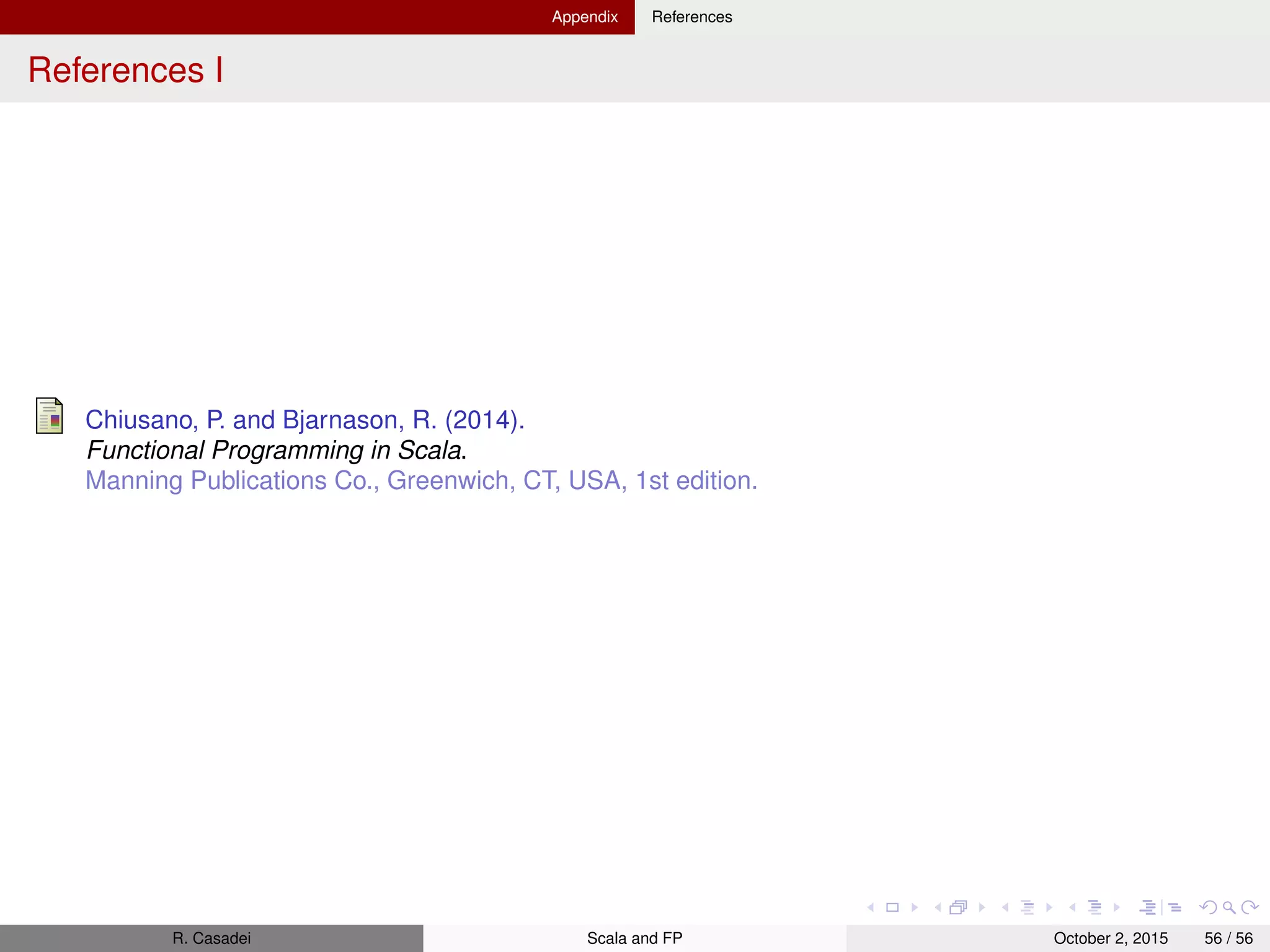This document provides an overview of functional programming in Scala. It begins with an introduction to functional programming basics like purity and referential transparency. It then covers functional data structures in Scala, including immutable lists. The document outlines topics on handling errors without exceptions, strict vs non-strict functions, purely functional state, and common FP structures like monoids and monads. Exercises are provided at the end to implement functions like tail, dropWhile, and foldLeft/foldRight on immutable lists.
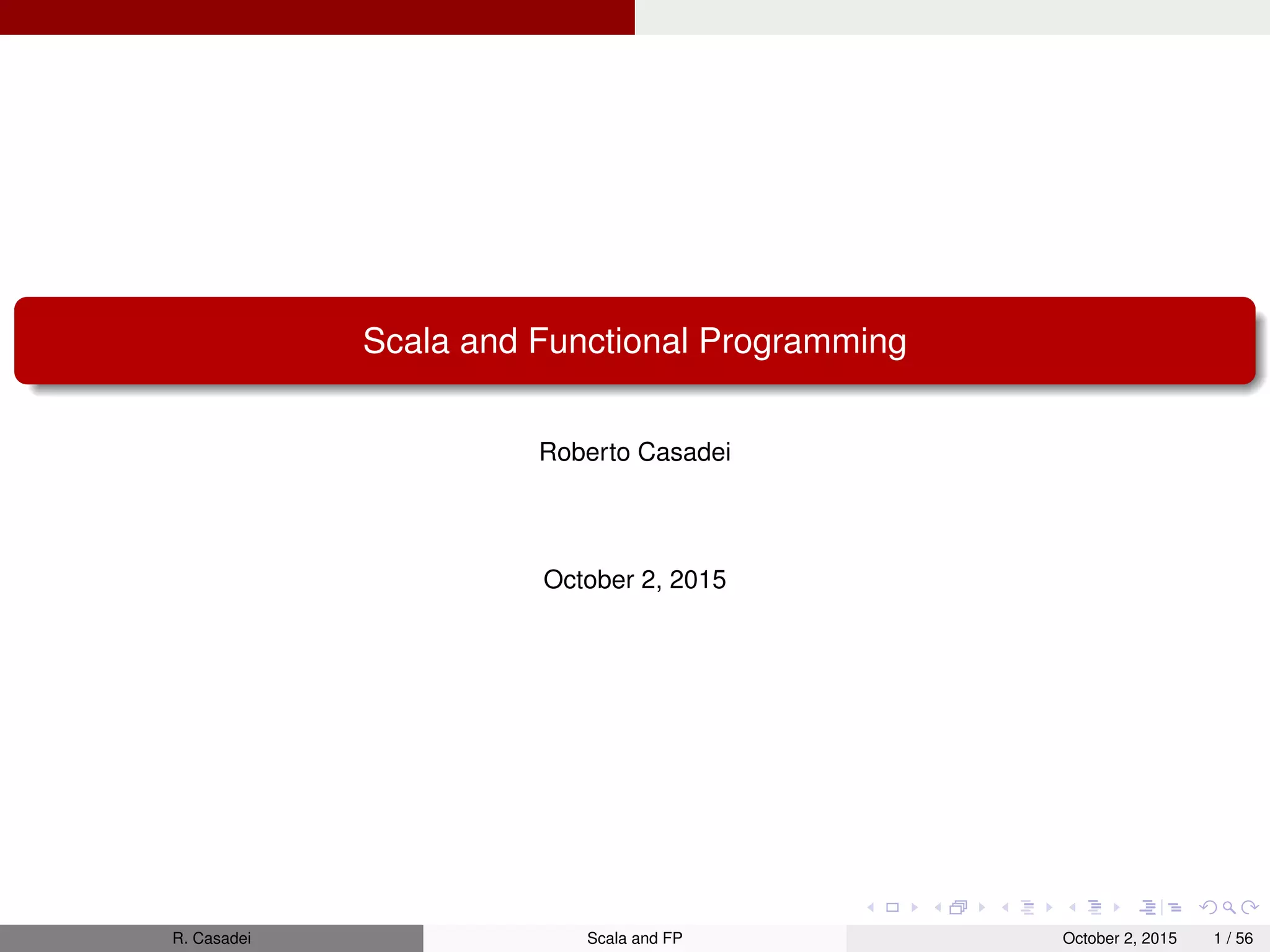
![About these notes I am a learner, not an expert These notes are essentially a work of synthesis and integration from many sources, such as “Functional Programming in Scala” [Chiusano and Bjarnason, 2014] University notes Web sources: Wikipedia, Blogs, etc. (references in slides) R. Casadei Scala and FP October 2, 2015 2 / 56](https://image.slidesharecdn.com/scalafunctionalprogramming-151002171002-lva1-app6891/75/Functional-Programming-in-Scala-Notes-2-2048.jpg)
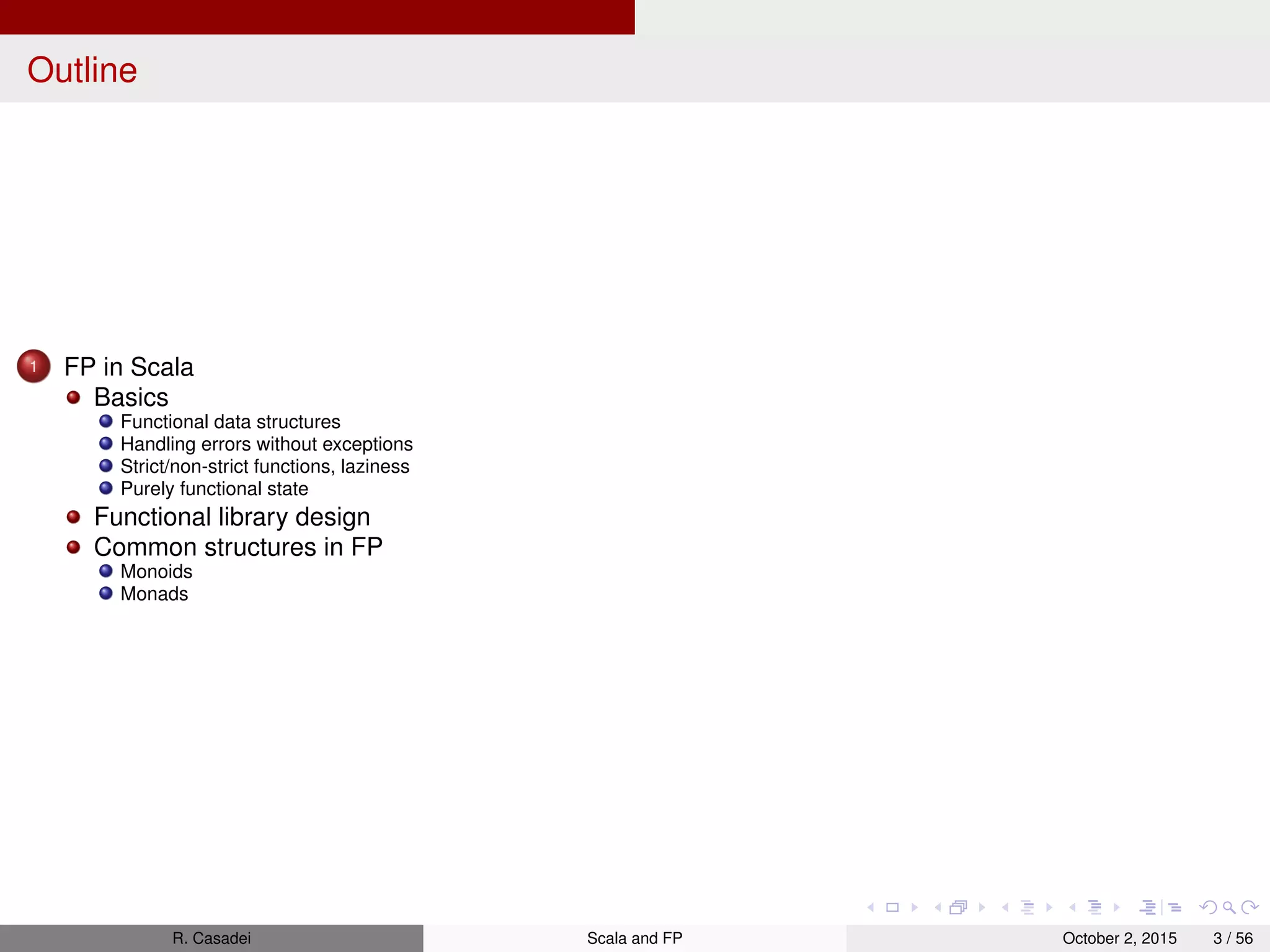

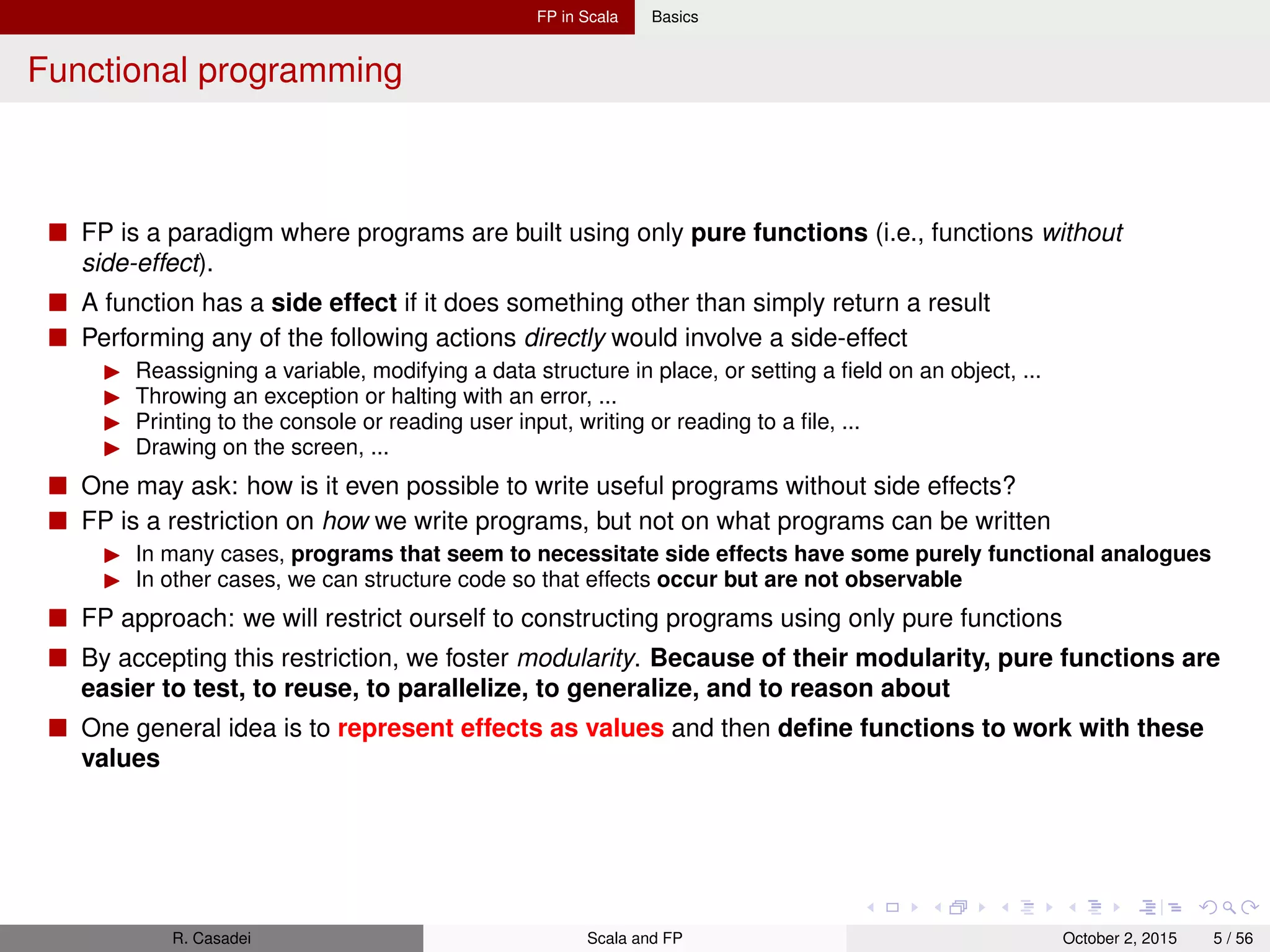
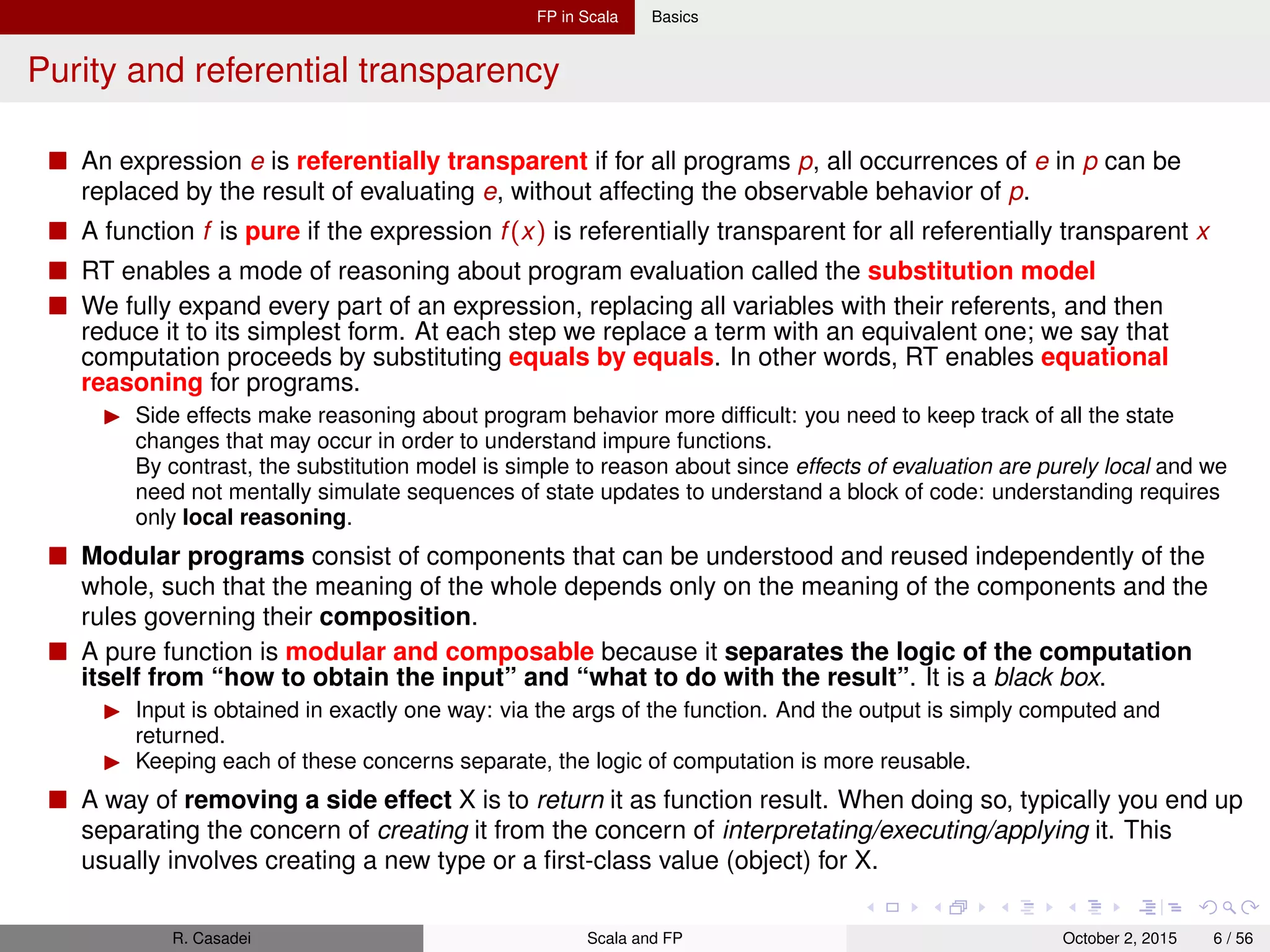
 => C): B => C = (b: B) => f(a, b) 2 3 def curry[A,B,C](f: (A, B) => C): A => (B => C) = { 4 // partial1(_,f) 5 a => b => f(a,b) 6 } 7 8 def sum(x:Int, y:Int) = x+y 9 val incByOne = partial1(1, sum) // incByOne: Int => Int = <function1> 10 incByOne(7) // res: Int = 8 11 val csum = curry(sum) // csum: Int => (Int => Int) = <function1> 12 csum(3)(7) // res: Int = 10 Ex 2.4:: Implement uncurry , which reverses the transformation of curry . Note that since => associates to the right, A => (B => C) can be written as A => B => C. R. Casadei Scala and FP October 2, 2015 7 / 56](https://image.slidesharecdn.com/scalafunctionalprogramming-151002171002-lva1-app6891/75/Functional-Programming-in-Scala-Notes-7-2048.jpg)
: (A, B) => C = { 2 // (a: A, b: B) => f(a)(b) // Verbose 3 // (a, b) => f(a)(b) // Use type inference 4 f(_)(_) // Use syntax sugar 5 } 6 7 val ucsum = uncurry(csum); sum(1,2) // 3 Ex 2.5:: Implement the higher-order function that composes two functions. 1 def compose[A,B,C](f: B => C, g: A => B): A => C = a => f(g(a)) 2 3 val incByTwo = compose(incByOne, incByOne) 4 incByTwo(2) // 4 Ex. 2.2: Impl isSorted, which checks if an Array[A] is sorted according to a given comparison function. 1 def isSortedNaive[A](as: Array[A], ordered: (A,A) => Boolean): Boolean = { 2 as sliding(2,1) map(e => ordered(e(0),e(1))) reduceLeft (_&&_) 3 } 4 // Note: building the pairs is not inefficient because ’sliding’ returns a (lazy) iterator 5 // And applying map to a lazy iterator also returns a lazy iterator 6 // But we could do better: we could stop at the first false! 7 8 def isSortedNaive2[A](as: Array[A], ordered: (A,A) => Boolean): Boolean = { 9 def sortAcc( acc: (Boolean, A), next: A): (Boolean,A) = (acc._1 && ordered(acc._2,next), next) 10 as.tail.foldLeft[(Boolean,A)]((true, as.head))(sortAcc)._1 11 } 12 // Note: leverage on short-circuit && (i.e., doesn’t check ’ordered’ after a first ’false’) 13 // But we could do better: we could stop at the first false! 14 15 def isSorted[A](as: Array[A], ordered: (A,A) => Boolean): Boolean = { 16 @annotation.tailrec def isSorted2[A](as: Array[A], ordered: (A,A) => Boolean, prev: Boolean, start: Int): Boolean = { 17 if(prev == false || (as.length-start)<2) prev 18 else isSorted2(as, ordered, ordered(as(start+0),as(start+1)), start+2) 19 } 20 isSorted2(as, ordered, true, 0) 21 } R. Casadei Scala and FP October 2, 2015 8 / 56](https://image.slidesharecdn.com/scalafunctionalprogramming-151002171002-lva1-app6891/75/Functional-Programming-in-Scala-Notes-8-2048.jpg)
 => Boolean): Boolean = { 26 @annotation.tailrec def go(n: Int): Boolean = 27 if (n >= as.length-1) true else if (gt(as(n), as(n+1))) false else go(n+1) 28 } 29 go(0) 30 } 31 32 // BEST-CASE 33 val array = (2 +: (1 to 10000000).toArray) 34 time { isSortedNaive[Int](array, (_<_)) } // Elapsed time: 6348ms ; res = false 35 time { isSortedNaive2[Int](array, (_<_)) } // Elapsed time: 2279ms ; res = false 36 time { isSorted[Int](array, (_<_)) } // Elapsed time: 0.82ms ; res = false 37 // WORST-CASE 38 val array2 = (1 to 10000000).toArray 39 time { isSortedNaive[Int](array2, (_<_)) } // Elapsed time: 7436ms; res = true 40 time { isSortedNaive2[Int](array2, (_<_)) } // Elapsed time: 2073ms; res = true 41 time { isSorted[Int](array2, (_<_)) } // Elapsed time: 187ms ; res = true R. Casadei Scala and FP October 2, 2015 9 / 56](https://image.slidesharecdn.com/scalafunctionalprogramming-151002171002-lva1-app6891/75/Functional-Programming-in-Scala-Notes-9-2048.jpg)
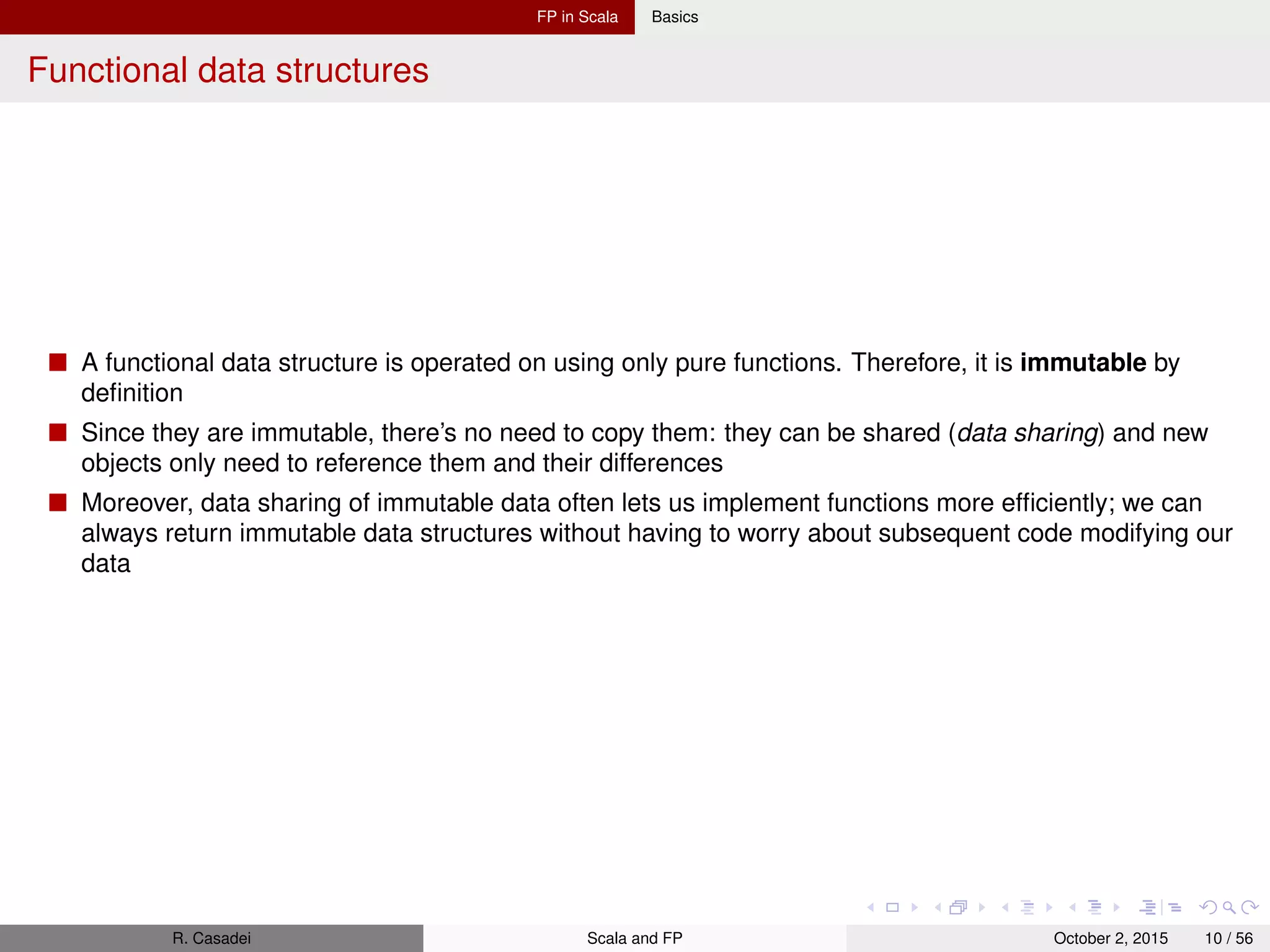
: List[A] = lst match { 2 case Nil => sys.error("tail on empty list") 3 case hd :: tail => tail 4 } 5 tail(List(1,2,3)) // List(2,3) Ex 3.3: Using the same idea, impl replaceHead for replacing the 1st elem of a List with a different value. 1 def replaceHead[A](lst: List[A], newHead: A): List[A] = lst match { 2 case Nil => sys.error("replaceHead on empty list") 3 case hd :: tail => newHead :: tail 4 } 5 replaceHead(List(1,2,3), 7) // List(7,2,3) Ex 3.4: Generalize tail to drop, which removes the first n elems from a list. Note that this function takes time proportional only to the number of elements being dropped—we don’t need to make a copy of the entire List. 1 def drop[A](lst: List[A], n: Int): List[A] = lst match { 2 case hd :: tail if n>0 => drop(tail, n-1) 3 case _ => lst 4 } 5 drop(List(1,2,3,4,5), 3) // List(4, 5) Ex 3.5: Impl dropWhile, which removes elems from the List prefix as long as they match a predicate. 1 def dropWhile[A](l: List[A], f: A => Boolean): List[A] = l match { 2 case hd :: tl if f(hd) => dropWhile(tl, f) 3 case _ => l 4 } 5 dropWhile[Int](List(2,4,6,7,8), n => n%2==0) // List(7, 8) R. Casadei Scala and FP October 2, 2015 11 / 56](https://image.slidesharecdn.com/scalafunctionalprogramming-151002171002-lva1-app6891/75/Functional-Programming-in-Scala-Notes-11-2048.jpg)
: List[A] = l match { 3 case hd :: Nil => Nil 4 case hd :: tl => hd :: init(tl) // Risk for stack overflow for large lists!!! 5 } 6 7 def initSolution[A](l: List[A]): List[A] = { 8 val buf = new collection.mutable.ListBuffer[A] 9 @annotation.tailrec def go(cur: List[A]): List[A] = cur match { 10 case Nil => sys.error("init of empty list") 11 case Cons(_,Nil) => List(buf.toList: _*) 12 case Cons(h,t) => buf += h; go(t) 13 } 14 go(l) 15 } // NOTE: the buffer is internal, so the mutation is not observable and RT is preserved!!! 16 17 init((1 to 5).toList) // List(1, 2, 3, 4) Ex 3.9: Compute the length of a list using foldRight. 1 def length[A](as: List[A]): Int = as.foldRight(0)((_,acc)=>acc+1) 2 3 length((5 to 10).toList) // res57: Int = 6 Ex 3.10: Write foldLeft 1 @annotation.tailrec 2 def foldLeft[A,B](as: List[A], z: B)(f: (B, A) => B): B = as match { 3 case Nil => z 4 case hd :: tl => foldLeft(tl, f(z, hd))(f) 5 } 6 foldLeft(List(5,6,7),0)(_+_) // res: Int = 18 R. Casadei Scala and FP October 2, 2015 12 / 56](https://image.slidesharecdn.com/scalafunctionalprogramming-151002171002-lva1-app6891/75/Functional-Programming-in-Scala-Notes-12-2048.jpg)
: List[A] = lst.foldLeft(List[A]())( (acc,e) => e :: acc) 2 3 reverse( 1 to 5 toList ) // List(5, 4, 3, 2, 1) Ex 3.13 (HARD): Can you write foldLeft in terms of foldRight? How about the other way around? Implementing foldRight via foldLeft is useful because it lets us implement foldRight tail-recursively, which means it works even for large lists without overflowing the stack. 1 def foldLeft[A,B](as: List[A], z: B)(f: (B, A) => B): B = { 2 as.reverse.foldRight(z)( (a,b) => f(b,a) ) 3 } 4 5 def foldRight[A,B](as: List[A], z: B)(f: (A, B) => B): B = { 6 as.reverse.foldLeft(z)( (a,b) => f(b,a) ) 7 } 8 9 // The following impls are interesting but not stack-safe 10 def foldRightViaFoldLeft2[A,B](l: List[A], z: B)(f: (A,B) => B): B = 11 foldLeft(l, (b:B) => b)((g,a) => b => g(f(a,b)))(z) 12 13 def foldLeftViaFoldRight2[A,B](l: List[A], z: B)(f: (B,A) => B): B = 14 foldRight(l, (b:B) => b)((a,g) => b => g(f(b,a)))(z) Ex 3.14: Implement append in terms of either foldLeft or foldRight. 1 def append[A](l: List[A], r: List[A]): List[A] = l.foldRight(r)(_::_) 2 3 append(1 to 3 toList, 5 to 9 toList) // List(1, 2, 3, 5, 6, 7, 8, 9) Ex 3.15 (HARD): Write a function that concatenates a list of lists into a single list. Its runtime should be linear in the total length of all lists. R. Casadei Scala and FP October 2, 2015 13 / 56](https://image.slidesharecdn.com/scalafunctionalprogramming-151002171002-lva1-app6891/75/Functional-Programming-in-Scala-Notes-13-2048.jpg)
: List[A] = foldRight(l, Nil:List[A])(append) 2 // Since append takes time proportional to its first argument, and this first argument never grows 3 // because of the right-associativity of foldRight, this function is linear in the total length of all lists. 4 5 concat(List(List(1,2),List(3,4))) // List(1,2,3,4) Ex 3.20: Write a function flatMap that works like map except that the function given will return a list instead of a single result, and that list should be inserted into the final resultinglist. 1 def flatMap[A,B](as: List[A])(f: A => List[B]): List[B] = concat( as.map(f) ) 2 3 flatMap(List(1,2,3))(i => List(i,i)) // List(1,1,2,2,3,3) Ex 3.21: Use flatMap to implement filter 1 def filter[A](as: List[A])(f: A => Boolean): List[A] = as.flatMap( e => if(f(e)) List(e) else Nil ) 2 3 filter(1 to 10 toList)(_%2==0) // List(2, 4, 6, 8, 10) R. Casadei Scala and FP October 2, 2015 14 / 56](https://image.slidesharecdn.com/scalafunctionalprogramming-151002171002-lva1-app6891/75/Functional-Programming-in-Scala-Notes-14-2048.jpg)
![FP in Scala Basics Handling errors without exceptions We said that throwing an exception breaks referential transparency The technique is based on a simple idea: instead of throwing an exception, we return a value indicating an exceptional condition has occurred. The big idea is that we can represent failures and exceptions with ordinary values, and write functions that abstract out common patterns of error handling. Possible alternatives to exceptions Return a bogus value – not so good: for some output types we might not have a sentinel value; may also allow errors to silently propagate; moreover, it demands a special policy or calling convention of callers Return null – not so good: it is only valid for non-primitive types; may also allow errors to silently propagate Force the caller to supply an argument which tells us what to do in case we don’t know how to handle the input – not so good: it requires the immediate callers have direct knowledge of how to handle the undefined case Option[T] – QUITE GOOD! We explicitly represent the return type that may not always have a defined value. We can think of this as deferring to the caller for the error handling strategy. Either[T] lets us track a reason for a failure 1 def safeDiv(x: Double, y: Double): Either[Exception, Double] = 2 try { Right(x / y) } catch { case e: Exception => Left(e) } R. Casadei Scala and FP October 2, 2015 15 / 56](https://image.slidesharecdn.com/scalafunctionalprogramming-151002171002-lva1-app6891/75/Functional-Programming-in-Scala-Notes-15-2048.jpg)
![FP in Scala Basics Option usage I 1 def lookupByName(name: String): Option[Employee] = ... 2 val joeDepartment: Option[String] = lookupByName("Joe").map(_.department) 3 // Note that we don’t need to explicitly check the result of lookupByName("Joe"); 4 // we simply continue the computation as if no error occurred}, inside the argument to map Note that we don’t have to check None at each stage of the computation. We can apply several transformations and then check for None when ready. A common pattern is to transform an Option via calls to map, flatMap, and/or filter, and then use getOrElse to do error handling at the end. 1 val dept = lookupByName("Joe").map(_.dept).filter(_ != "Accounting").getOrElse("Default Dept") Another common idiom is to do to convert None back to an exception 1 o.getOrElse(throw new Exception("FAIL")) Option lifting It may be easy to jump to the conclusion that once we start using Option , it infects our entire code base. One can imagine how any callers of methods that take or return Option will have to be modified to handle either Some or None. But this simply doesn’t happen, and the reason why is that we can lift ordinary functions to become functions that operate on Option. For example, the map function lets us operate on values of type Option[A] using a function of type A => B, returning Option[B]. Another way of looking at this is that map turns a function f: A => B into a function of type Option[A] => Option[B] R. Casadei Scala and FP October 2, 2015 16 / 56](https://image.slidesharecdn.com/scalafunctionalprogramming-151002171002-lva1-app6891/75/Functional-Programming-in-Scala-Notes-16-2048.jpg)
![FP in Scala Basics Option usage II 1 def inc(x: Int) = x+1 2 Some(5) map inc // res: Option[Int] = Some(6) 3 None map inc // res: Option[Int] = None It’s also possible to lift a function by using a for-comprehension, which in Scala is a convenient syntax for writing a sequence of nested calls to map and flatMap You can lift a PartialFunction[A,B] to a PartialFunction[A,Option[B]] by calling its lift method Converting exception-based APIs to Option-based APIs We may introduce a Try function for the purpose 1 // The function is non-strict or lazy argument (Note the use of call-by-name param) 2 def Try[A](a: => A): Option[A] = try Some(a) catch { case e: Exception => None } Suppose now we need to call a function insuranceRateQuote(age: Int, numOfTickets: Int): Double if the parsing of both age and numOfTickets is successful (they may arrive from a web request...). If we use Try(age.toInt) and get an option, how can we call that method? We can use pattern matching but that’s going to be tedious. We could leverage on a function map2 that combines two Option values and, if either Option value is None, then the return value is too. R. Casadei Scala and FP October 2, 2015 17 / 56](https://image.slidesharecdn.com/scalafunctionalprogramming-151002171002-lva1-app6891/75/Functional-Programming-in-Scala-Notes-17-2048.jpg)
(f: (A, B) => C): Option[C] = (a,b) match { 2 case (Some(a),Some(b)) => Some(f(a,b)) 3 case _ => None 4 } 5 // Another solution 6 def map2[A,B,C](a: Option[A], b: Option[B])(f: (A, B) => C): Option[C] = 7 a flatMap (aa => b map (bb => f(aa, bb))) 8 9 map2[Int,Int,Int](Some(1),None )(_+_) // None 10 map2[Int,Int,Int](None, Some(1))(_+_) // None 11 map2[Int,Int,Int](Some(3),Some(1))(_+_) // Some(4) Then we could implement our Option-based API 1 def parseInsuranceRateQuote(age: String, numOfTickets: String): Option[Double] = { 2 val optAge: Option[Int] = Try { age.toInt } 3 val optTickets: Option[Int] = Try { numberOfSpeedingTickets.toInt } 4 map2(optAge, optTickes)(insuranceRateQuote) 5 } map2 allows to lift any 2-arg function. We could also define map3, map4, .... But we could generalize it in a function sequence that combines a list of Options into one Option containing a list of all the Some values in the original list. If the original list contains None even once, the result of the function should be None; otherwise the result should be Some with a list of all the values R. Casadei Scala and FP October 2, 2015 18 / 56](https://image.slidesharecdn.com/scalafunctionalprogramming-151002171002-lva1-app6891/75/Functional-Programming-in-Scala-Notes-18-2048.jpg)
: Option[List[A]] = Try { 2 a map (o => o match { case Some(x) => x }) 3 } 4 5 // Another solution 6 def sequence[A](a: List[Option[A]]): Option[List[A]] = a match { 7 case Nil => Some(Nil) 8 case h :: t => h flatMap (hh => sequence(t) map (hh :: _)) 9 } 10 11 // Another solution 12 def sequence_1[A](a: List[Option[A]]): Option[List[A]] = 13 a.foldRight[Option[List[A]]](Some(Nil))((x,y) => map2(x,y)(_ :: _)) 14 15 sequence(List(Some(1),Some(2),Some(3))) // Some(List(1, 2, 3)) 16 sequence(List(Some(1),None,Some(3))) // None Sometimes we’ll want to map over a list using a function that might fail, returning None if applying it to any element of the list returns None. For example 1 def parseInts(a: List[String]): Option[List[Int]] = sequence(a map (i => Try(i.toInt))) But it’s inefficient since it traverses the list twice. Try to impl a generic traverse that looks at the list once. 1 /* Note: it assumes that f has no side effects */ 2 def traverse[A, B](a: List[A])(f: A => Option[B]): Option[List[B]] = Try { 3 a.map(x => f(x) match { case Some(y) => y }) 4 } 5 6 def parseInts(a: List[String]): Option[List[Int]] = traverse(a)(i => Try(i.toInt)) 7 8 parseInts( List("1","2","3") ) // Some(List(1, 2, 3)) 9 parseInts( List("1","2","a", "3") ) // None R. Casadei Scala and FP October 2, 2015 19 / 56](https://image.slidesharecdn.com/scalafunctionalprogramming-151002171002-lva1-app6891/75/Functional-Programming-in-Scala-Notes-19-2048.jpg)
![FP in Scala Basics Either usage I Option[T] doesn’t tell us anything about what went wrong in the case of an exceptional condition. All it can do is to give us None, indicating that there’s no value to be had. Sometimes we want to no more, e.g., a string with some info or the exception that happened We could define a type Either which is a disjoint union of two types. We use the Left data constructor for errors, and Right for success case. Note: as for Option, there’s a Either type in the Scala library which is slighly different from the one used here for pedagogical purpose 1 sealed abstract class Either[+E, +A] { 2 def map[B](f: A => B): Either[E, B] 3 def flatMap[EE >: E, B](f: A => Either[EE, B]): Either[EE, B] 4 def orElse[EE >: E,B >: A](b: => Either[EE, B]): Either[EE, B] 5 def map2[EE >: E, B, C](b: Either[EE, B])(f: (A, B) => C): Either[EE, C] 6 } 7 case class Left[+E](value: E) extends Either[E, Nothing] 8 case class Right[+A](value: A) extends Either[Nothing, A] 9 10 // Example: mean 11 def mean(xs: IndexedSeq[Double]): Either[String, Double] = 12 if (xs.isEmpty) Left("mean of empty list!") else Right(xs.sum / xs.length) 13 14 // Example: Try 15 def Try[A](a: => A): Either[Exception, A] = try Right(a) catch { case e: Exception => Left(e) } 16 17 // Example: Either can be used in for-comprehension 18 def parseInsuranceRateQuote(age: String, numOfTickets: String): Either[Exception,Double] = 19 for { a <- Try { age.toInt }; tickets <- Try { numOfTickets.toInt } } 20 yield insuranceRateQuote(a, tickets) R. Casadei Scala and FP October 2, 2015 20 / 56](https://image.slidesharecdn.com/scalafunctionalprogramming-151002171002-lva1-app6891/75/Functional-Programming-in-Scala-Notes-20-2048.jpg)
![FP in Scala Basics Exercises from Chapter 4: Handling errors without exceptions I Ex 5.1: implement the funtions of the Option trait. As you impl each function, try to think about what it means and in what situations you’d use it. 1 sealed trait Option[+A] 2 case class Some[+A](get: A) extends Option[A] 3 case object None extends Option[Nothing] 4 5 // Impl of methods 6 sealed trait Option[+A] { 7 // Apply f, which may fail, to the Option if not None. 8 // Map is similar to flatMap but f() doesn’t need to wrap its result in an Option 9 def map[B](f: A => B): Option[B] = this match { 10 case None => None 11 case Some(a) => Some(f(a)) // Note, wrt to ’flatMap’, here we wrap the result 12 } 13 14 // Apply f, which may fail, to the Option if not None. 15 // Similar to map, but f is expected to return an option 16 def flatMap[B](f: A => Option[B]): Option[B] = map(f) getOrElse None 17 18 // Another impl of flatMap 19 def flatMap[B](f: A => Option[B]): Option[B] = this match { 20 case None => None 21 case Some(a) => f(a) // Note, wrt to ’map’, here we don’t wrap the result 22 } 23 24 def getOrElse[B >: A](default: => B): B = this match { 25 case None => default 26 case Some(a) => a 27 } 28 29 // Provide an alternative option value (note: doesn’t eval ob unless needed) 30 def orElse[B >: A](ob: => Option[B]): Option[B] = this map (Some(_)) getOrElse ob 31 32 def orElse[B >: A](ob: => Option[B]): Option[B] = this match { 33 case None => ob 34 case _ => this 35 } 36 37 // Convert Some to None if the value doesn’t satisfy f 38 def filter(f: A => Boolean): Option[A] = this match { R. Casadei Scala and FP October 2, 2015 21 / 56](https://image.slidesharecdn.com/scalafunctionalprogramming-151002171002-lva1-app6891/75/Functional-Programming-in-Scala-Notes-21-2048.jpg)
![FP in Scala Basics Exercises from Chapter 4: Handling errors without exceptions II 39 case Some(a) if f(a) => this 40 case _ => None 41 } 42 } Note that in map/flatMap the function is not run if this option is None! Ex 4.2: Implement the variance function in terms of flatMap. If the mean of a sequence is m, the variance is the mean of math.pow(x-m, 2) for each element x in the sequence. 1 def mean(xs: Seq[Double]): Option[Double] = 2 if (xs.isEmpty) None else Some(xs.sum / xs.length) 3 def variance(s: Seq[Double]): Option[Double] = 4 mean(s) flatMap (m => mean(s.map(x => math.pow(x-m, 2)))) 5 variance(List(5,7,8)) // Some(1.5554) 6 variance(List()) // None 7 8 // WITH MAP 9 def mean2(xs: Seq[Double]): Double = xs.sum / xs.length 10 // If xs.isEmpty (i.e., xs.length = 0), mean2 will return Double.NaN 11 def varianceWithMap(s: Seq[Double]): Option[Double] = 12 mean(s) map (m => mean2(s.map(x => math.pow(x-m, 2)))) 13 // But here you’ll never get NaN because the first map gives you None for empty lists As the implementation of variance demonstrates, with flatMap we can construct a computation with multiple stages, any of which may fail, and the computation will abort as soon as the first failure is encountered, since None.flatMap(f) will immediately return None, without running f. Ex 4.6: implement versions of map, flatMap, orElse, map2 on Either that operate on the Right value R. Casadei Scala and FP October 2, 2015 22 / 56](https://image.slidesharecdn.com/scalafunctionalprogramming-151002171002-lva1-app6891/75/Functional-Programming-in-Scala-Notes-22-2048.jpg)
![FP in Scala Basics Exercises from Chapter 4: Handling errors without exceptions III 1 sealed trait Either[+E, +A] { 2 def map[B](f: A => B): Either[E, B] = this match { 3 case Right(a) => Right(f(a)) 4 case Left(e) => Left(e) 5 } 6 7 def flatMap[EE >: E, B](f: A => Either[EE, B]): Either[EE, B] = this match { 8 case Right(a) => f(a) 9 case Left(e) => Left(e) 10 } 11 12 def orElse[EE >: E,B >: A](b: => Either[EE, B]): Either[EE, B] = this match { 13 case Right(a) => Right(a) 14 case Left(_) => b 15 } 16 17 def map2[EE >: E, B, C](b: Either[EE, B])(f: (A, B) => C): Either[EE, C] = 18 flatMap(aa => b.flatMap(bb => Right(f(aa,bb)))) 19 } Ex 4.7: impl sequence and traverse for Either. These should return the first error encountered (if any) 1 def sequence[E, A](es: List[Either[E, A]]): Either[E, List[A]] = { 2 def seqhelp[E, A](es: List[Either[E, A]], res: List[A]): Either[E, List[A]] = es match { 3 case Nil => Right(res) 4 case Left(e) :: _ => Left(e) 5 case Right(a) :: tl => seqhelp(tl, res :+ a) 6 } 7 seqhelp(es, List[A]()) 8 } 9 sequence(List(Right(1),Right(2),Right(3))) // Right(List(1, 2, 3)) 10 sequence(List(Right(1),Left("err"),Right(3),Left("err2"))) // Left(err1) 11 12 def traverse[E,A,B](es: List[A])(f: A => Either[E, B]): Either[E, List[B]] = 13 es.foldRight[Either[E,List[B]]](Right(Nil))((a, b) => f(a).map2(b)(_ :: _)) 14 15 // sequence can be impl in terms of traverse 16 def sequence[E, A](es: List[Either[E, A]]): Either[E, List[A]] = 17 traverse(es)(a => a) R. Casadei Scala and FP October 2, 2015 23 / 56](https://image.slidesharecdn.com/scalafunctionalprogramming-151002171002-lva1-app6891/75/Functional-Programming-in-Scala-Notes-23-2048.jpg)
![FP in Scala Basics Exercises from Chapter 4: Handling errors without exceptions IV Ex 4.8: In our impl, map2 is only able to report one error. What would you need to change in order to report both errors? If we want to accumulate multiple errors, a simple approach is a new data type that lets us keep a list of errors in the data constructor that represents failures: 1 trait Partial[+A,+B] 2 case class Errors[+A](get: Seq[A]) extends Partial[A,Nothing] 3 case class Success[+B](get: B) extends Partial[Nothing,B] There is a type very similar to this called Validation in the Scalaz library R. Casadei Scala and FP October 2, 2015 24 / 56](https://image.slidesharecdn.com/scalafunctionalprogramming-151002171002-lva1-app6891/75/Functional-Programming-in-Scala-Notes-24-2048.jpg)
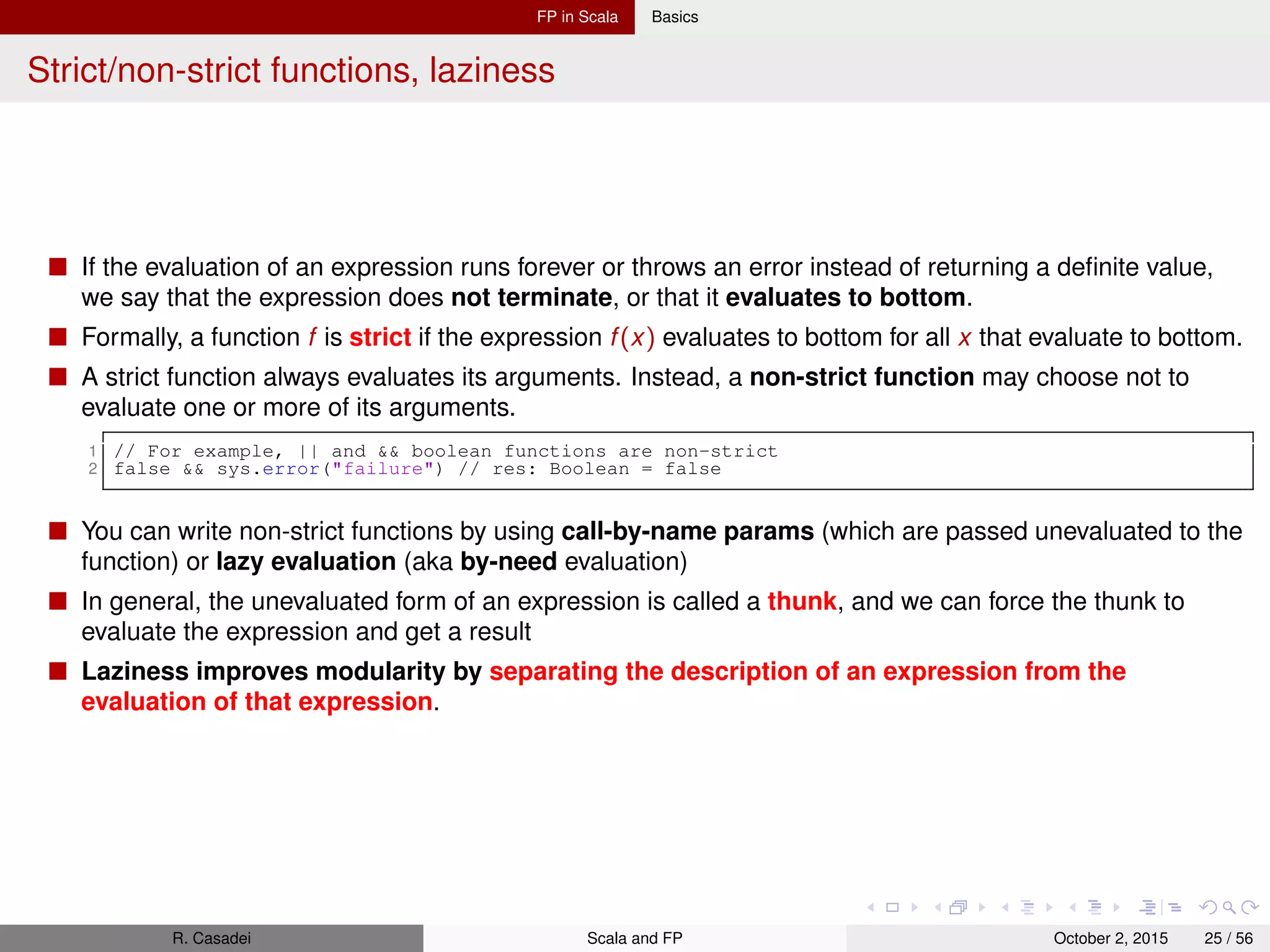
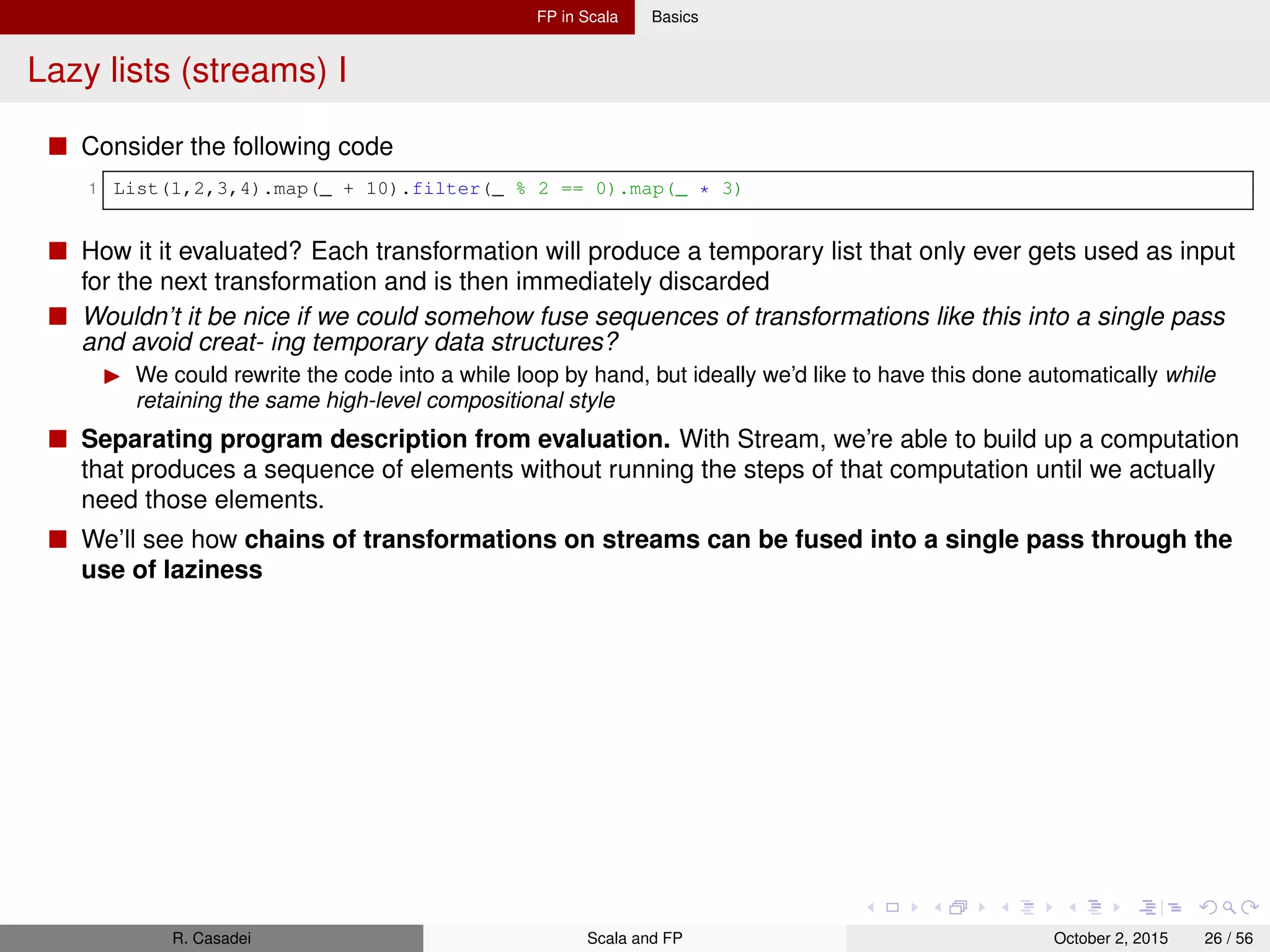
![FP in Scala Basics Lazy lists (streams) II Simple implementation of Stream 1 sealed trait Stream[+A]{ 2 def headOption(): Option[A] = this match { 3 case Empty => None 4 case Cons(h, t) => Some(h()) // Explicit force of h 5 } 6 } 7 case object Empty extends Stream[Nothing] 8 case class Cons[+A](h: () => A, t: () => Stream[A]) extends Stream[A] 9 10 object Stream { 11 def cons[A](hd: => A, tl: => Stream[A]): Stream[A] = { 12 lazy val head = hd 13 lazy val tail = tl 14 Cons(() => head, () => tail) 15 } 16 def empty[A]: Stream[A] = Empty 17 def apply[A](as: A*): Stream[A] = if (as.isEmpty) empty else cons(as.head, apply(as.tail: _*)) 18 } Note cons takes explicit thunks instead of regular strict values In headOption, we explicitly force the head thunk Memoizing streams and avoiding recomputations We typically want to cache the values of a Cons node, once they are forced This is achieved using lazy vals in cons The empty smart constructor returns Empty but annotates it as a Stream[A] which is better for type inference in some cases. R. Casadei Scala and FP October 2, 2015 27 / 56](https://image.slidesharecdn.com/scalafunctionalprogramming-151002171002-lva1-app6891/75/Functional-Programming-in-Scala-Notes-27-2048.jpg)
![FP in Scala Basics Lazy lists (streams) III Helper functions for inspecting stream: write toList, take, drop, takeWhile (exercises 5.1, 5.2, 5.3) 1 sealed trait Stream[+A] { 2 def toListRecursive: List[A] = this match { 3 case Empty => Nil 4 case Cons(hd,tl) => hd() :: tl().toList() // Will stack overflow for large stream 5 } 6 def toList: List[A] = { 7 @annotation.tailrec def go(s: Stream[A], acc: List[A]): List[A] = s match { 8 case Cons(hd,tl) => go(tl(), hd()::acc) 9 case _ => acc 10 }; go(this, List()).reverse // the reverse is not optimal (second pass) 11 } 12 def toListFast: List[A] = { // Using a mutable list buffer 13 val buf = new collection.mutable.ListBuffer[A] 14 @annotation.tailrec def go(s: Stream[A]): List[A] = s match { 15 case Cons(h,t) => { buf += h(); go(t()) } 16 case _ => buf.toList 17 }; go(this) 18 } 19 def take(n: Int): Stream[A] = this match { // Note: take generates its answer lazily 20 case Cons(h, t) if n>=1 => Cons(h(), tl().take(n-1)) 21 case Cons(h, t) if n==0 => Cons(h(), empty) 22 case _ => empty 23 } 24 @annotation.tailrec def drop(n: Int): Stream[A] = this match { // Not lazy 25 case Cons(_, t) if n>0 => t().drop(n-1) 26 case _ => this 27 } 28 def takeWhile(p: A => Boolean): Stream[A] = this match { 29 case Cons(h, t) if p(h()) => Cons(h(), t().takeWhile(p)) 30 case _ => empty 31 } 32 @annotation.tailrec def dropWhile(p: A => Boolean): Stream[A] = this match { 33 case Cons(h, t) if p(h()) => t().dropWhile(p) 34 case _ => this 35 } R. Casadei Scala and FP October 2, 2015 28 / 56](https://image.slidesharecdn.com/scalafunctionalprogramming-151002171002-lva1-app6891/75/Functional-Programming-in-Scala-Notes-28-2048.jpg)
![FP in Scala Basics Lazy lists (streams) IV Separating program description from program evaluation 1 sealed trait Stream[+A] { 2 3 def foldRight[B](z: => B)(f: (A, => B) => B): B = this match { 4 case Cons(h,t) => f(h(), t().foldRight(z)(f)) // NOTE THE CALL TO f() 5 case _ => z 6 } If f, which is non-strict in its 2nd arg, choses to not evaluate it, this terminates the traversal early. And since foldRight can terminate the traversal early, we can reuse it to implement exists and other useful methods 1 def exists(p: A => Boolean): Boolean = foldRight(false)((a,b) => p(a)||b) Ex 5.4: impl forAll which checks if all elems of the stream match a given predicate. It should terminate the traversal as soon as a nonmatching value is encountered. 1 def forAll(p: A => Boolean): Boolean = foldRight(true)((a,b) => p(a)&&b) Use foldRight to impl takeWhile (ex. 5.5) 1 def takeWhile(p: A => Boolean): Stream[A] = 2 foldRight(empty[A])((a,b) => if(p(a)) Cons(a,b) else empty) Use foldRight to impl headOption (ex. 5.6 HARD) 1 def headOption: Option[A] = 2 foldRight(None)((a,_) => ) R. Casadei Scala and FP October 2, 2015 29 / 56](https://image.slidesharecdn.com/scalafunctionalprogramming-151002171002-lva1-app6891/75/Functional-Programming-in-Scala-Notes-29-2048.jpg)
: Stream[B] = 2 foldRight(empty[B])((a,t) => Cons(f(a), t)) 3 4 def filter(p: A => Boolean): Stream[A] = 5 foldRight(empty[A])((a,t) => if(p(a)) Cons(a,t) else t) 6 7 def append[B>:A](s: => Stream[B]): Stream[B] = foldRight(s)((a,t) => Cons(a,t)) 8 9 def flatMap(f: A => Stream[B]): Stream[B] = 10 foldRight(empty[B])((a,t) => f(a) append t) Note that these implementations are incremental: they don’t fully generate their answers. It’s not until some other computation looks at the elements of the resulting Stream that the computation to generate that Stream actually takes place. Because of this incremental nature, we can call these functions one after another without fully instantiating the intermediate results Program trace for Stream 1 Stream(1,2,3,4).map(_ + 10).filter(_ % 2 == 0).toList 2 cons(11, Stream(2,3,4).map(_ + 10)).filter(_ % 2 == 0).toList // apply ’map’ to 1st elem 3 Stream(2,3,4).map(_ + 10).filter(_ % 2 == 0).toList // apply ’filter’ to 1st elem 4 cons(12, Stream(3,4).map(_ + 10)).filter(_ % 2 == 0).toList // apply ’map’ to 2nd elem 5 12 :: Stream(3,4).map(_ + 10).filter(_ % 2 == 0).toList // apply ’filter’ and produce elem 6 12 :: cons(13, Stream(4).map(_ + 10)).filter(_ % 2 == 0).toList 7 12 :: Stream(4).map(_ + 10).filter(_ % 2 == 0).toList 8 12 :: cons(14, Stream().map(_ + 10)).filter(_ % 2 == 0).toList 9 12 :: 14 :: Stream().map(_ + 10).filter(_ % 2 == 0).toList // apply ’filter’ to 4th elem 10 12 :: 14 :: List() // map and filter have no more work to do, and empty stream becomes empty list R. Casadei Scala and FP October 2, 2015 30 / 56](https://image.slidesharecdn.com/scalafunctionalprogramming-151002171002-lva1-app6891/75/Functional-Programming-in-Scala-Notes-30-2048.jpg)
![FP in Scala Basics Lazy lists (streams) VI Since intermediate streams aren’t instantiated, it’s easy to reuse existing combinators in novel ways without having to worry that we’re doing more processing of the stream than necessary. For example, we can reuse filter to define find, a method to return just the first element that matches if it exists. Even though filter transforms the whole stream, that transformation is done lazily, so find terminates as soon as a match is found. 1 def find(p: A => Boolean): Option[A] = filter(p).headOption R. Casadei Scala and FP October 2, 2015 31 / 56](https://image.slidesharecdn.com/scalafunctionalprogramming-151002171002-lva1-app6891/75/Functional-Programming-in-Scala-Notes-31-2048.jpg)
![FP in Scala Basics Infinite streams and corecursion I Because they’re incremental, the functions we’ve written also work for infinite streams. 1 val ones: Stream[Int] = Stream.cons(1, ones) 2 ones.take(5).toList // List(1,1,1,1,1) 3 ones.exists(_ % 2 != 0) // true 4 ones.forAll(_ == 1) // OPSSSS! It’ll never terminate R. Casadei Scala and FP October 2, 2015 32 / 56](https://image.slidesharecdn.com/scalafunctionalprogramming-151002171002-lva1-app6891/75/Functional-Programming-in-Scala-Notes-32-2048.jpg)
: Stream[A] = Cons(a, constant(a)) 3 4 // We can make it more efficient with just one object referencing itself 5 def constant[A](a: A): Stream[A] = { 6 lazy val tail: Stream[A] = Cons(() => a, () => tail) 7 tail 8 } Ex 5.9: impl from(n) which returns the infinite stream n, n + 1, n + 2, .. 1 def from(n: Int): Stream[Int] = Cons(n, from(n+1)) Ex 5.10: impl fibs which returns an infinite stream of Fibonacci numbers 1 def fibs(): Stream[Int] = { 2 def fib(x1: Int, x2: Int): Stream[Int] = Cons(x1, fib(x2, x1+x2)) 3 Cons(0, 1) 4 } Ex 5.11: write a more general stream-building function called unfold. It takes an initial state, and a function for producing both the next state and the next value in the generated stream. Option is used to indicate when the Stream should be terminated, if at all 1 def unfold[A, S](z: S)(f: S => Option[(A, S)]): Stream[A] = f(z) match { 2 case None => Empty 3 case Some((res, nextState)) => Cons(res, unfold(nextState)(f)) 4 } R. Casadei Scala and FP October 2, 2015 33 / 56](https://image.slidesharecdn.com/scalafunctionalprogramming-151002171002-lva1-app6891/75/Functional-Programming-in-Scala-Notes-33-2048.jpg)
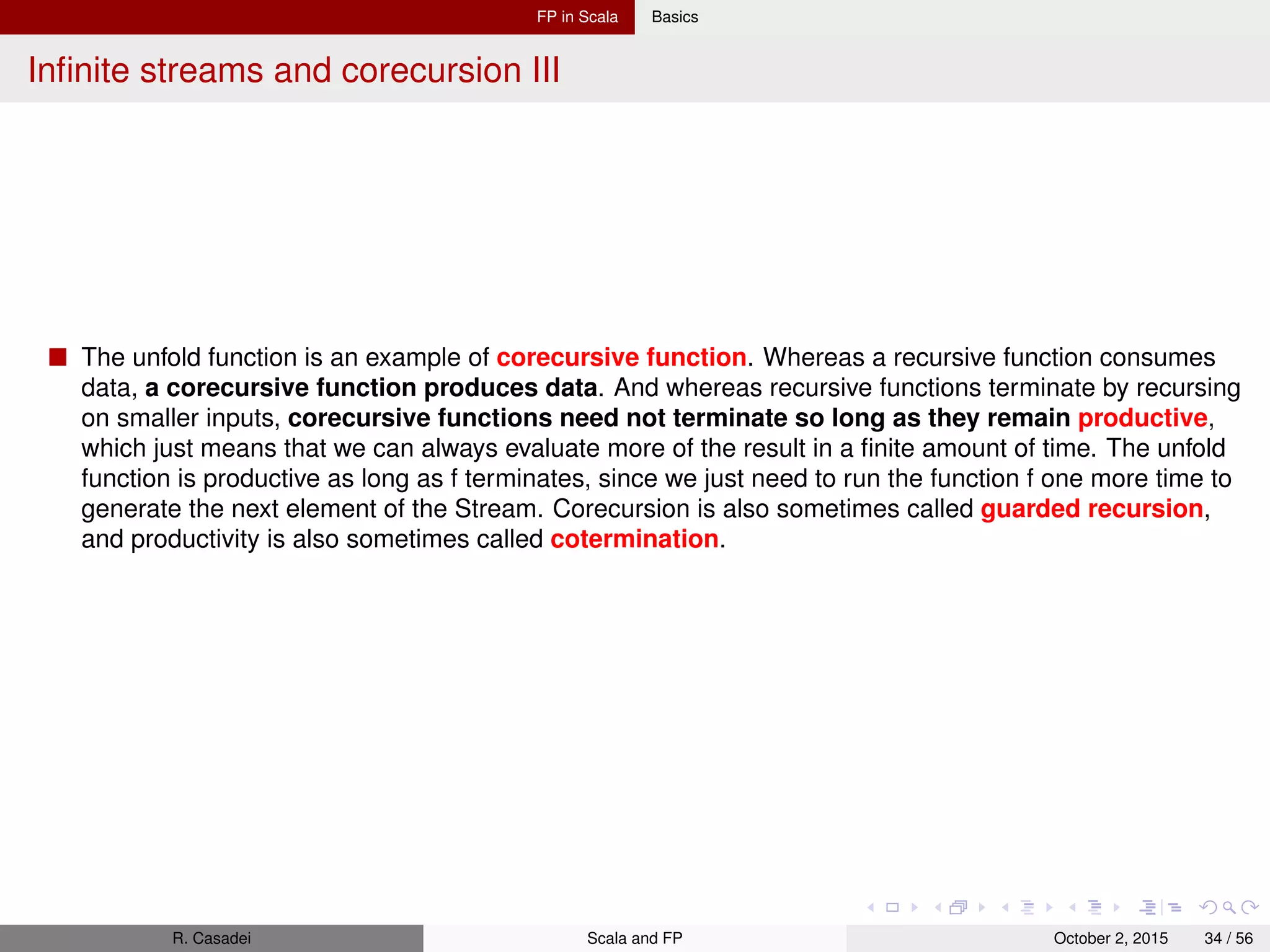
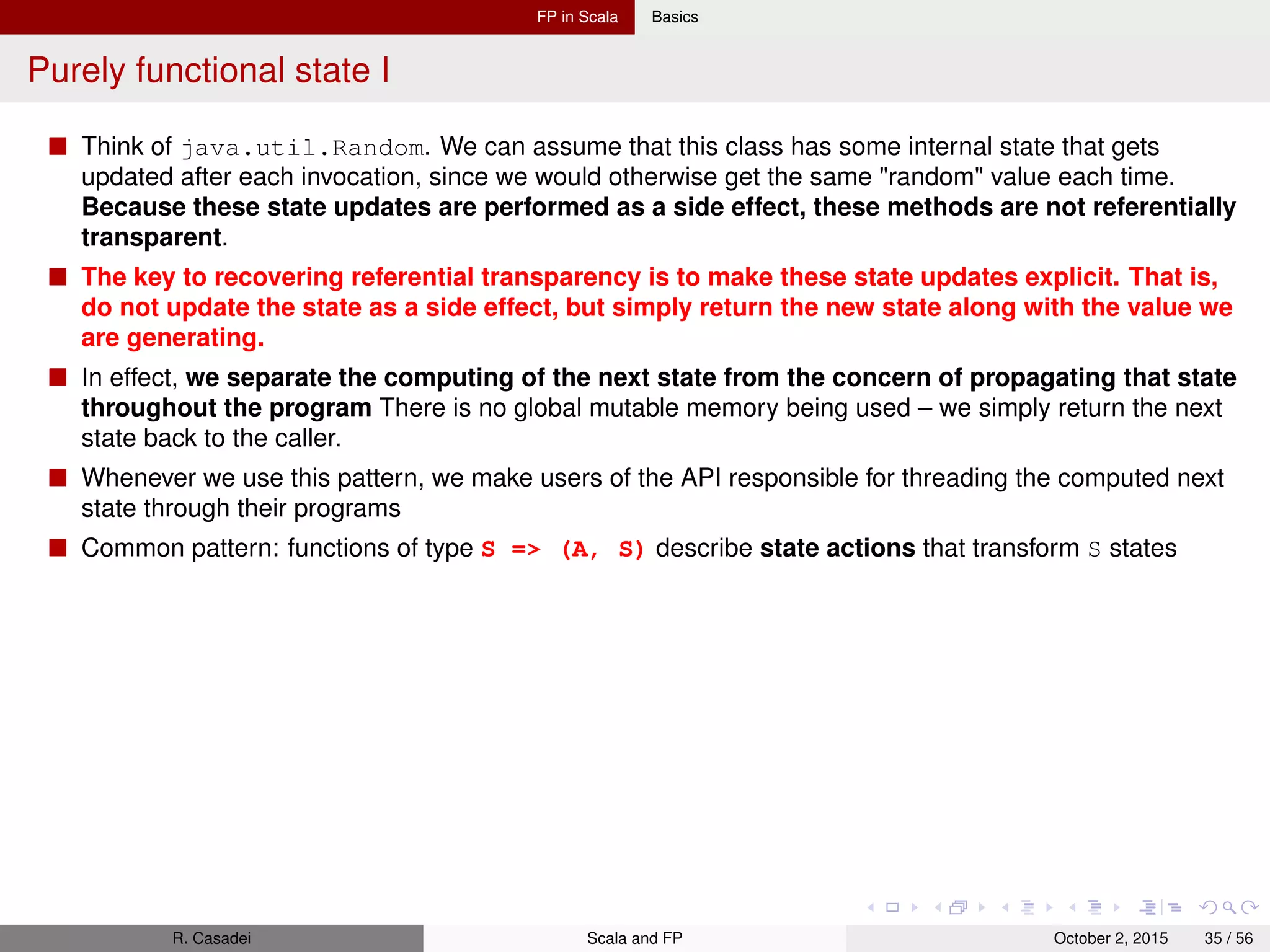
![FP in Scala Basics Purely functional state II 1 trait RNG { 2 def nextInt: (Int, RNG) 3 } 4 5 case class SimpleRNG(seed: Long) extends RNG { 6 def nextInt: (Int, RNG) = { 7 val newSeed = (seed * 0x5DEECE66DL + 0xBL) & 0xFFFFFFFFFFFFL 8 val nextRNG = SimpleRNG(newSeed) 9 val n = (newSeed >>> 16).toInt 10 (n, nextRNG) 11 } 12 } 13 14 val rng1 = new SimpleRNG(77) // rng1: SimpleRNG = SimpleRNG(77) 15 val (n1, rng2) = rng1.nextInt // n1: Int = 29625665, rng2: RNG = SimpleRNG(1941547601620) 16 val (n2, rng3) = rng2.nextInt // n2: Int = 1226233105, rng3: RNG = SimpleRNG(80362412771407) 17 18 val int: Rand[Int] = _.nextInt 19 val (n3, rng4) = int(rng) 20 21 def ints(count: Int)(rng: RNG): (List[Int], RNG) = count match { 22 case n if n<=0 => (Nil, rng) 23 case n => { 24 val (r, rng2) = rng.nextInt 25 val (tail, rngLast) = ints(n-1)(rng2) 26 (r :: tail, rngLast) 27 } 28 } 29 30 val (rints, rng5) = ints(3)(rng4) // rints: List[Int] = List(-615319858, -1013832981, 88185503) 31 // rng2: RNG = SimpleRNG(5779325172636) R. Casadei Scala and FP October 2, 2015 36 / 56](https://image.slidesharecdn.com/scalafunctionalprogramming-151002171002-lva1-app6891/75/Functional-Programming-in-Scala-Notes-36-2048.jpg)
![FP in Scala Basics Purely functional state III Ex 6.1: impl a RNG to gen a nonNegativeInt (between 0 and Int.MaxValue). Handle the corner case of Int.MinValue which hasn’t a non-negative counterpart. 1 def nonNegativeInt(rng: RNG): (Int, RNG) = { 2 val (i, r) = rng.nextInt 3 (if(i<0) -(i+1) else i, r) 4 } Ex 6.2: impl a RNG of double values between 0 and 1 (NOT inclusive) 1 def double(rng: RNG): (Double, RNG) = { 2 val (n, r) = nonNegativeInt(rng) 3 (n / (Int.MaxValue.toDouble + 1), r) 4 } Ex 6.3: impl a RNG to gen a (Int, Double) pair 1 def intDouble(rng: RNG): ((Int,Double), RNG) = { 2 val (i, r1) = rng.nextInt 3 val (d, r2) = double(r1) 4 ((i, d), r2) 5 } Ex 6.4: impl a function to generate a list of random ints 1 def ints(count: Int)(rng: RNG): (List[Int], RNG) = { 2 @annotation.tailrec def go(n: Int, r: RNG, acc: List[Int]): (List[Int], RNG) = n match { 3 case n if n<=0 => (acc, r) 4 case n => { val (i,r2) = r.nextInt; go(n-1, r2, i::acc) } 5 } 6 go(count, rng, List()) 7 } R. Casadei Scala and FP October 2, 2015 37 / 56](https://image.slidesharecdn.com/scalafunctionalprogramming-151002171002-lva1-app6891/75/Functional-Programming-in-Scala-Notes-37-2048.jpg)
![FP in Scala Basics Purely functional state IV A better API for state actions Since it’s pretty tedious and repetitive to pass the state along ourselves, we want our combinators to pass the state from one action to the next automatically 1 // Type alias for the RNG state action data type 2 // Rand[A] is a function that expects a RNG to produce A values (and the next state) 3 type Rand[+A] = RNG => (A, RNG) 4 5 // The "unit" action passes the RNG state through without using it, 6 // always returning a constant value rather than a random value. 7 def unit[A](a: A): Rand[A] = rng => (a, rng) 8 9 // The "map" action transforms the output of a state action without modifying the state itself 10 def map[A,B](s: Rand[A])(f: A => B): Rand[B] = rng => { 11 val (a, rng2) = s(rng) 12 (f(a), rng2) 13 } 14 15 // EX 6.6 The "map2" action combines 2 RNG actions into one using a binary rather than unary fn. 16 def map2[A,B,C](ra: Rand[A], rb: Rand[B])(f: (A, B) => C): Rand[C] = rng => { 17 val (a, r1) = ra(rng) 18 val (b, r2) = rb(r1) 19 (f(a,b), r2) 20 } 21 22 def both[A,B](ra: Rand[A], rb: Rand[B]): Rand[(A,B)] = map2(ra, rb)((_, _)) 23 24 // EX 6.7. The "sequence" action combines a List of transitions into a single transition 25 def sequence[A](fs: List[Rand[A]]): Rand[List[A]] = rng => { 26 @annotation.tailrec 27 def go(lst: List[Rand[A]], acc: List[A], rng: RNG): Rand[List[A]] = lst match { 28 case Nil => unit(acc)(_) 29 case gen :: tl => { val (x,r) = gen(rng); go(tl, x::acc, r) } 30 } 31 go(fs, List(), rng)(rng) 32 } 33 // Another solution 34 def sequence[A](fs: List[Rand[A]]): Rand[List[A]] = 35 fs.foldRight(unit(List[A]()))((f, acc) => map2(f, acc)(_ :: _)) R. Casadei Scala and FP October 2, 2015 38 / 56](https://image.slidesharecdn.com/scalafunctionalprogramming-151002171002-lva1-app6891/75/Functional-Programming-in-Scala-Notes-38-2048.jpg)
![FP in Scala Basics Purely functional state V 36 37 // "flatMap" allows us to generate a random A with a function Rand[A], 38 // and then take that A and choose a Rand[B] based on its value 39 def flatMap[A,B](f: Rand[A])(g: A => Rand[B]): Rand[B] = rng => { 40 val (a, rnga) = f(rng) 41 g(a)(rnga) 42 } Now we can implement previous functions more easily 1 // EXERCISE 6.5: use ’map’ to reimplement ’double’ in a more elengant way 2 val randDouble: Rand[Double] = map(nonNegativeInt)(_ / (Int.MaxValue.toDouble+1)) 3 4 val randIntDouble: Rand[(Int,Double)] = both((_:RNG).nextInt, randDouble) 5 6 // EXERCISE 6.7: use ’sequence’ to reimplement ’ints’ 7 def ints(n: Int): Rand[List[Int]] = sequence((1 to n).map(_ => (_:RNG).nextInt).toList) 8 9 // EXERCISE 6.8: use ’flatMap’ to implement ’nonNegativeLessThan’ 10 def nonNegativeLessThan(ub: Int): Rand[Int] = 11 flatMap(nonNegativeInt)(n => if(n>=ub) nonNegativeLessThan(ub) else unit(n)) 12 13 // EXERCISE 6.9: reimpl map and map2 in terms of flatMap 14 def map[A,B](s: Rand[A])(f: A => B): Rand[B] = 15 flatMap(s)(a => unit(f(a))) 16 17 def map2[A,B,C](ra: Rand[A], rb: Rand[B])(f: (A, B) => C): Rand[C] = 18 flatMap(ra)(a => flatMap(rb)(b => unit(f(a,b)))) 19 // for(a <- ra; b <- rb) yield(unit(f(a,b))) 20 // To use for-comprehension we need to add flatMap to Rand[T] R. Casadei Scala and FP October 2, 2015 39 / 56](https://image.slidesharecdn.com/scalafunctionalprogramming-151002171002-lva1-app6891/75/Functional-Programming-in-Scala-Notes-39-2048.jpg)
) { 2 def apply(s: S) = run(s) 3 4 def unit[A](a: A): State[S, A] = new State(s => (a, s)) 5 6 def map[B](f: A => B): State[S, B] = new State(s => { 7 val (a, s2) = run(s) 8 (f(a), s2) 9 }) 10 11 def map2[B,C](rb: State[S,B])(f: (A, B) => C): State[S,C] = new State(s => { 12 val (a, s2a) = run(s) 13 val (b, s2b) = rb.run(s) 14 (f(a,b), s2a) 15 }) 16 17 def flatMap[B](g: A => State[S,B]): State[S, B] = new State[S,B]( s => { 18 val (a, s2) = run(s) 19 g(a, s2) 20 }) 21 } 22 23 type Rand[A] = State[RNG, A] 24 25 val int: Rand[Int] = new State(rng => rng.nextInt) 26 def ints(count: Int): Rand[List[Int]] = count match { 27 case n if n<=0 => new State(s => (Nil, s)) 28 case n => new State (rng => { 29 val (r, rng2) = rng.nextInt 30 val (tail, rngLast) = ints(n-1).run(rng2) 31 (r :: tail, rngLast) 32 }) 33 } 34 35 val randomNums = ints(3).map(lst => lst map (_.toDouble)).run(new SimpleRNG(0)) 36 // randomNums: (List[Double], RNG) = (List(0.0, 4232237.0, 1.7880379E8),SimpleRNG(11718085204285)) Purely functional imperative programming R. Casadei Scala and FP October 2, 2015 40 / 56](https://image.slidesharecdn.com/scalafunctionalprogramming-151002171002-lva1-app6891/75/Functional-Programming-in-Scala-Notes-40-2048.jpg)
![FP in Scala Basics Purely functional state VII In the imperative programming paradigm, a program is a sequence of statements where each statement may modify the program state. That’s exactly what we’ve been doing, except that our “statements” are really State actions, which are really functions FP and imperative programming are not necessarily the opposite: it is reasonable to maintain state without side effects We implemented some combinators like map, map2, and ultimately flatMap to handle the propagation of the state from one statement to the next. But in doing so, we seem to have lost a bit of the imperative mood... That’s not actually the case! 1 val ns: Rand[List[Int]] = int.flatMap(x => int.flatMap(y => ints(x).map(xs => xs.map(_ % y)))) 2 3 val ns: Rand[List[Int]] = for { 4 x <- int; 5 y <- int; 6 xs <- ints(x) 7 } yield xs.map(_ % y) // Oh yeah! Now it really seems imperative! ;) To facilitate this kind of imperative programming with for-comprehensions (or flatMaps), we really only need two primitive State combinators: one for reading the state and one for writing the state 1 def get[S]: State[S, S] = State(s => (s, s)) // pass state along and returns it as value 2 def set[S](s: S): State[S, Unit] = State(_ => ((), s)) // ignores current state 3 def modify[S](f: S => S): State[S, Unit] = for { 4 s <- get // get current state 5 _ <- set(f(s)) // set new state 6 } yield () get, set, map, map2, flatMap are all the tools we need to implement any kind of state machine or stateful program in a purely functional way R. Casadei Scala and FP October 2, 2015 41 / 56](https://image.slidesharecdn.com/scalafunctionalprogramming-151002171002-lva1-app6891/75/Functional-Programming-in-Scala-Notes-41-2048.jpg)

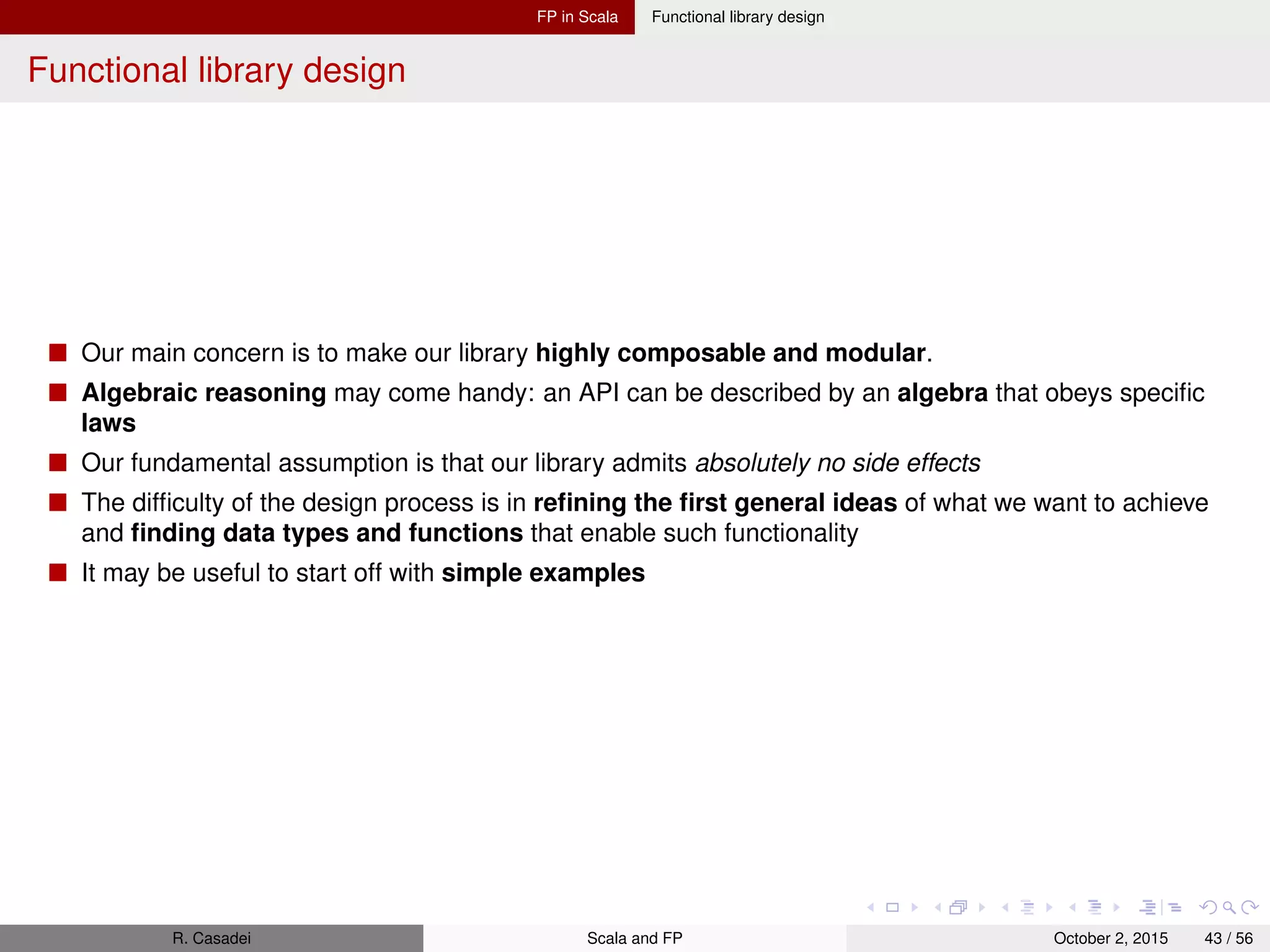
![FP in Scala Functional library design Purely function parallelism I We’ll strive to separate the concern of describing a computation from actually running it. We’d like to be able to “create parallel computations”, but what does that mean exactly? We may initially consider a simple, parallelizable computation – the sum of a list of integers. 1 def sum(ints: Seq[Int]): Int = ints.foldLeft(0)((a,b) => a + b) Ehy, we can break the sequence into parts that can be processed in parallel! 1 def sum(ints: IndexedSeq[Int]): Int = 2 if(ints.size <= 1){ 3 ints.headOption getOrElse 0 4 } else { 5 val (l,r) = ints.splitAt(ints.length/2) 6 sum(l) + sum(r) 7 } Any data type we might choose to represent our parallel computations needs to be able to contain a result, which should be of some meaningful type. Of course, we also require some way of extracting that result. We invent Par[A], our container type for our result def unit[A](a: => A): Par[A] takes an unevaluated A and returns a computation that may evaluate it in a separate thread; it creates a unit of parallelism that just wraps a single value def get[A](a: Par[A]): A for extracting the resulting value from the parallel computation 1 def sum(ints: IndexedSeq[Int]): Int = 2 if(ints.size <= 1){ 3 ints.headOption getOrElse 0 4 } else { 5 val (l,r) = ints.splitAt(ints.length/2) 6 val sumL: Par[Int] = Par.unit(sum(l)) 7 val sumR: Par[Int] = Par.unit(sum(r)) 8 Par.get(sumL) + Par.get(sumR) 9 } R. Casadei Scala and FP October 2, 2015 44 / 56](https://image.slidesharecdn.com/scalafunctionalprogramming-151002171002-lva1-app6891/75/Functional-Programming-in-Scala-Notes-44-2048.jpg)
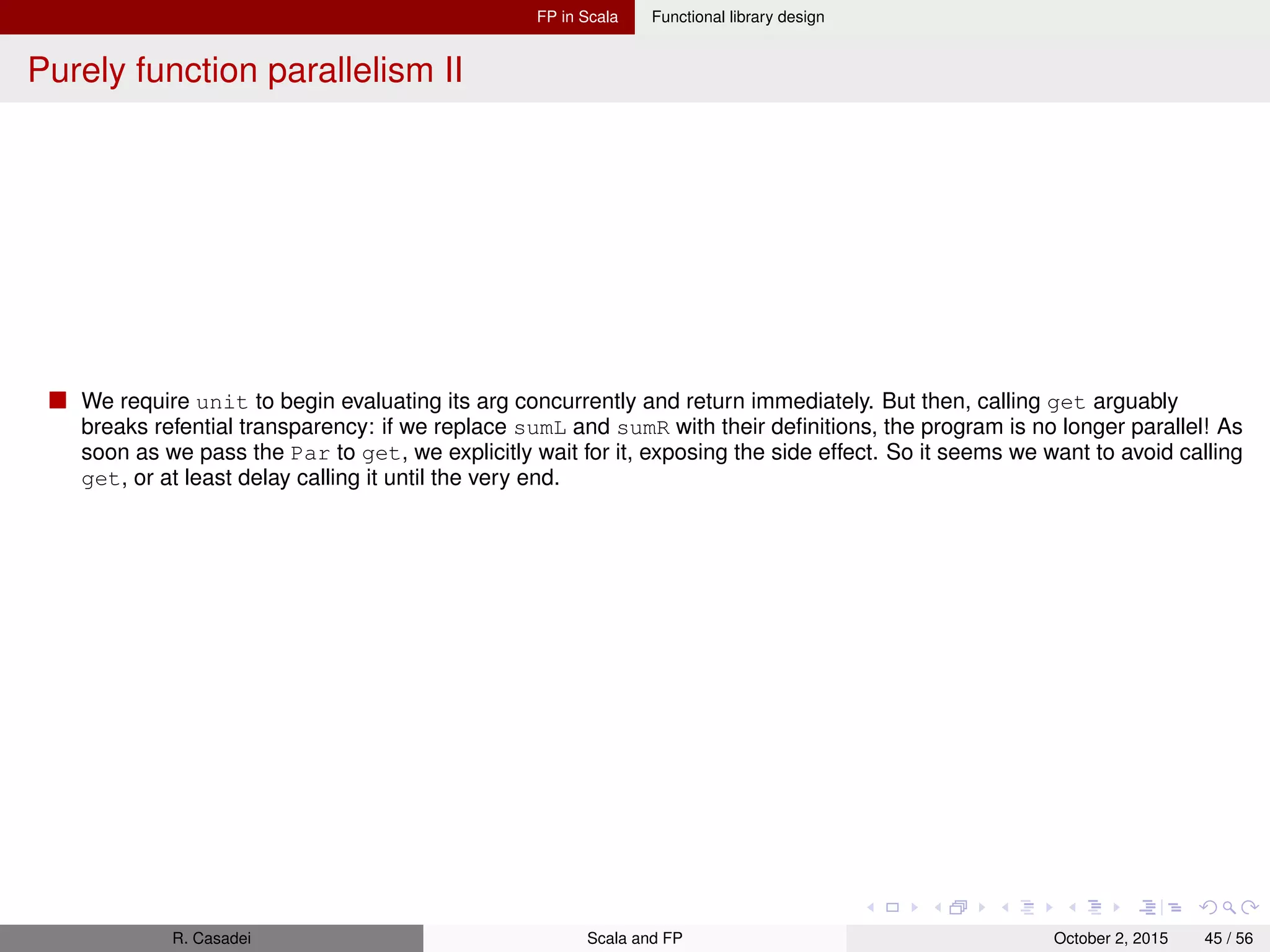
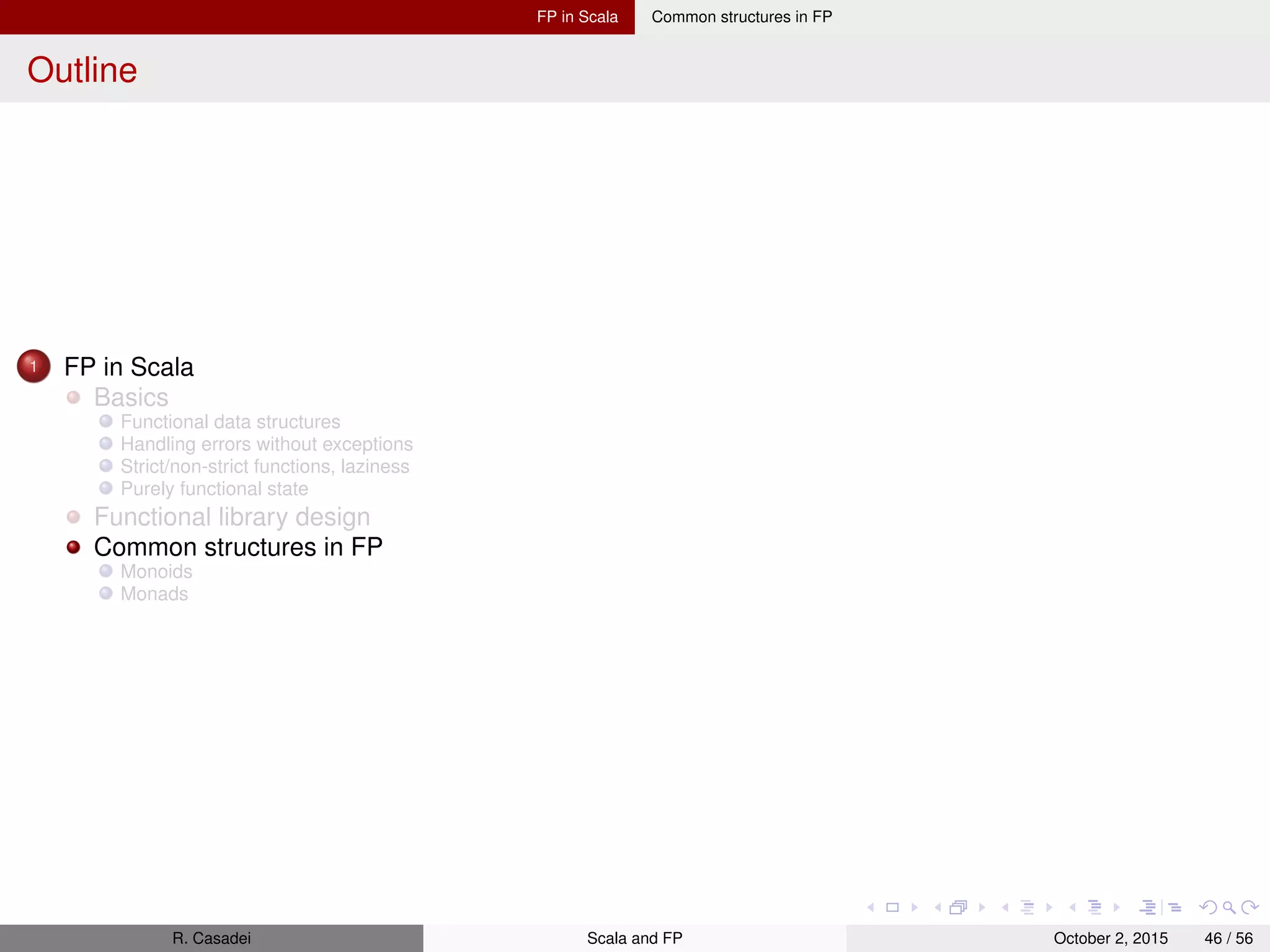
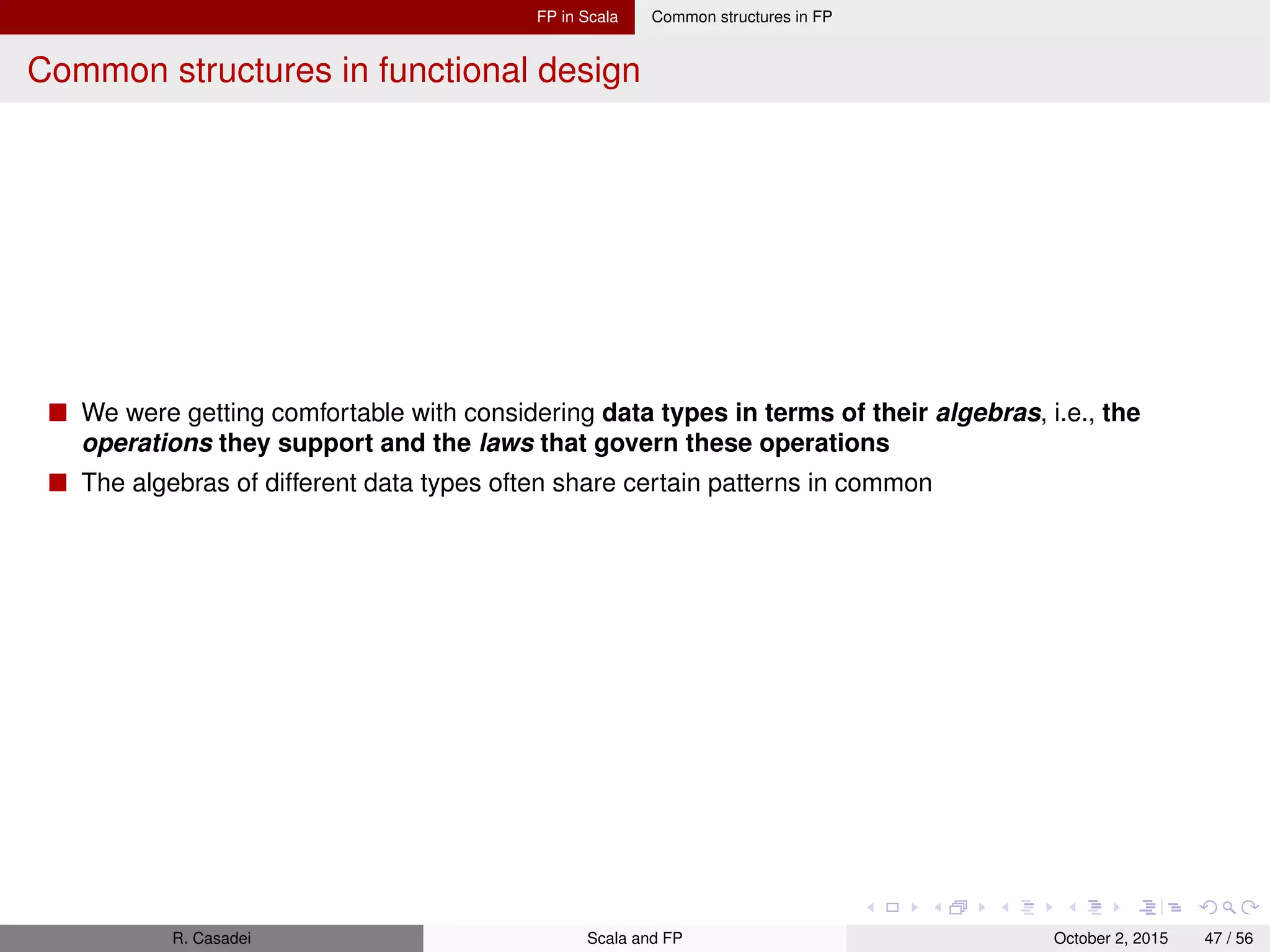
![FP in Scala Common structures in FP Monoids In abstract algebra, a monoid is an algebraic structure with a single associative binary operation and an identity element. In category theory, a monoid is a category with a single object Thus, monoids capture the idea of function composition within a set A monoid is a purely algebraic structure (i.e., it is defined only by its algebra) Examples The algebra of string concatenation – We can concatenate “a”+“b” to get “ab”; that operation is associative, i.e., (a+b)+c=a+(b+c) and the empty string is an identity element for that operation. Integer addition (0 is identity elem); multiplication (1 is identity) The boolean operators && and || (identity is true and false, respectively) So, a monoid is an algebra that consists of: Some type A An associative binary operation op An identity value zero for that operation 1 trait Monoid[A] { 2 def op(a1: A, a2: A): A 3 def zero: A 4 } 5 6 val stringMonoid = new Monoid[String] { 7 def op(a1: String, a2: String) = a1 + a2 8 val zero = "" 9 } The laws of associativity and identity are known as the monoid laws R. Casadei Scala and FP October 2, 2015 48 / 56](https://image.slidesharecdn.com/scalafunctionalprogramming-151002171002-lva1-app6891/75/Functional-Programming-in-Scala-Notes-48-2048.jpg)
![FP in Scala Common structures in FP More on monoids I Exercise 10.2: give a monoid for combining Option values 1 def optionMonoid[A]: Monoid[Option[A]] = new Monoid[Option[A]] { 2 def op(op1: Option[A], op2: Option[A]): Option[A] = op1 orElse op2 3 def zero: Option[A] = None 4 } Exercise 10.3: give a monoid for endofunctions (i.e., functions with same argument and return type) 1 def endoMonoid[A]: Monoid[A => A] = new Monoid[A => A] { 2 def op(f1: A=>A, f2: A=>A): A => A = f1 compose f2 3 def zero: A=>A = a => a 4 } Use ScalaCheck properties to test your monoids 1 import org.scalacheck.Prop.forAll 2 val o = optionMonoid[Int] 3 val opAssociativity = forAll { 4 (a:Option[Int], b:Option[Int], c:Option[Int]) => o.op(o.op(a,b),c) == o.op(a,o.op(b,c)) 5 } 6 val identity = forAll { (a: Option[Int]) => o.op(o.zero, a) == a && o.op(a, o.zero) == a } 7 (opAssociativity && identity).check // OK: passed 100 tests (On terminology) Having vs. being a monoid: sometimes people talk about a type being a monoid versus having a monoid instance. Actually the monoid is both the type and the instance satisfying the laws. More precisely, the type A forms a monoid under the operations defined by the Monoid[A] instance. In summary, a monoid is simply a type A and an implementation of Monoid[A] that satisfies the laws. Stated tersely, a monoid is a type together with a binary operation (op) over that type, satisfying associativity and having an identity element (zero). R. Casadei Scala and FP October 2, 2015 49 / 56](https://image.slidesharecdn.com/scalafunctionalprogramming-151002171002-lva1-app6891/75/Functional-Programming-in-Scala-Notes-49-2048.jpg)
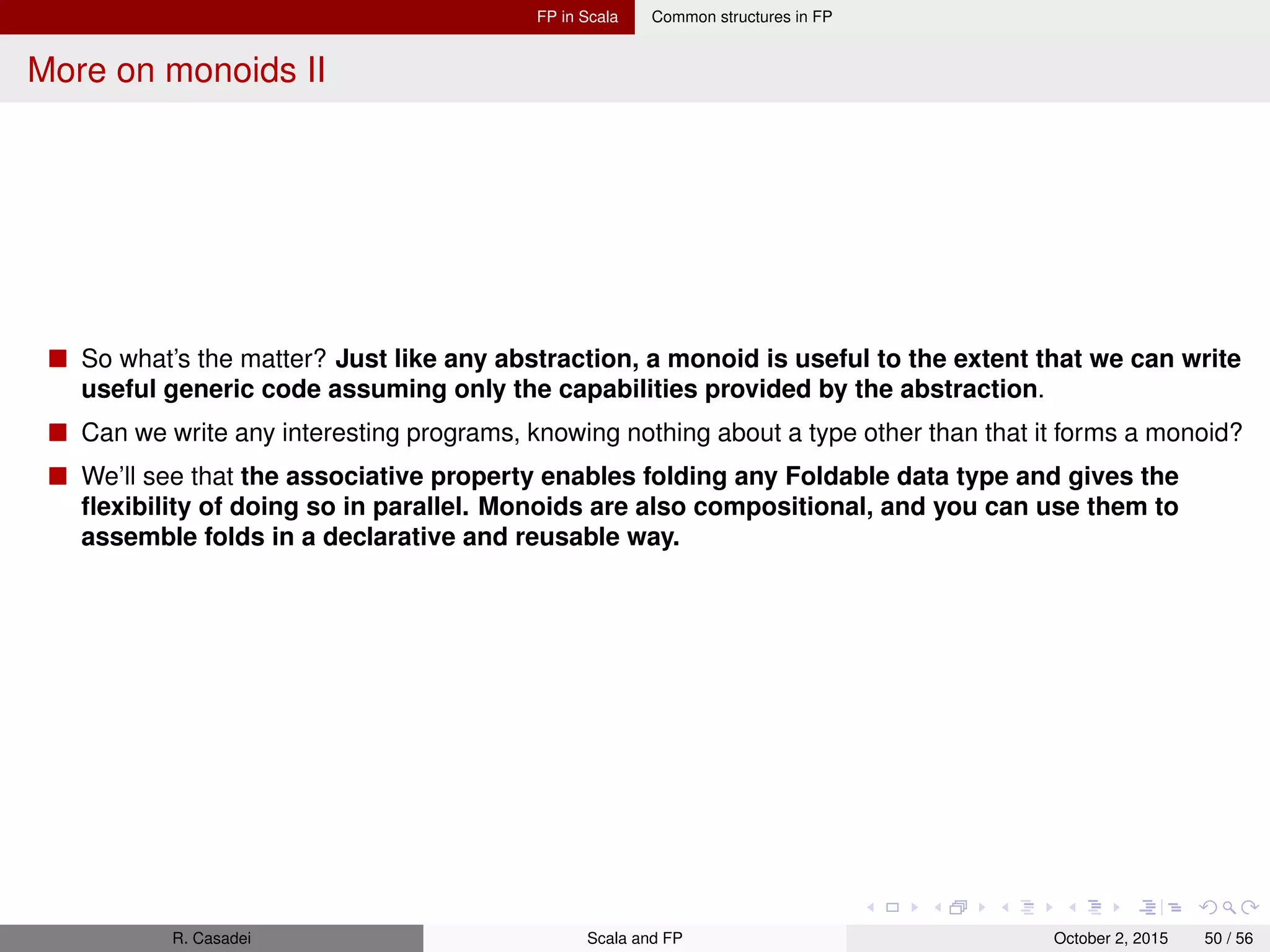
(f: (A, B) => B): B 2 def foldLeft[B](z: B)(f: (B, A) => B): B The components of a monoid fit these argument types like a glove. 1 val words = List("a","b","c") 2 val s = words.foldRight(stringMonoid.zero)(stringMonoid.op) // "abc" 3 val t = words.foldLeft(stringMonoid.zero)(stringMonoid.op) // "abc" Note that it doesn’t matter if we choose foldLeft or foldRight when folding with a monoid; we should get the same result. This is precisely because the laws of associativity and identity hold. We can write a general function concatenate that folds a list with a monoid: 1 def concatenate[A](as: List[A], m: Monoid[A]): A = as.foldLeft(m.zero)(m.op) But what if our list has an element type that doesn’t have a Monoid instance? Well, we can always map over the list to turn it into a type that does 1 // EXERCISE 10.5 2 def foldMap[A,B](as: List[A], m: Monoid[B])(f: A => B): B = 3 (as map f).foldLeft(m.zero)(m.op) 4 5 // EXERCISE 10.6 (HARD) You can also write foldLeft and foldRight using foldMap 6 def foldRight[A, B](as: List[A])(z: B)(f: (A, B) => B): B = 7 foldMap(as, endoMonoid[B])(f.curried)(z) 8 9 def foldLeft[A, B](as: List[A])(z: B)(f: (B, A) => B): B = 10 foldMap(as, dual(endoMonoid[B]))(a => b => f(b, a))(z) R. Casadei Scala and FP October 2, 2015 51 / 56](https://image.slidesharecdn.com/scalafunctionalprogramming-151002171002-lva1-app6891/75/Functional-Programming-in-Scala-Notes-51-2048.jpg)
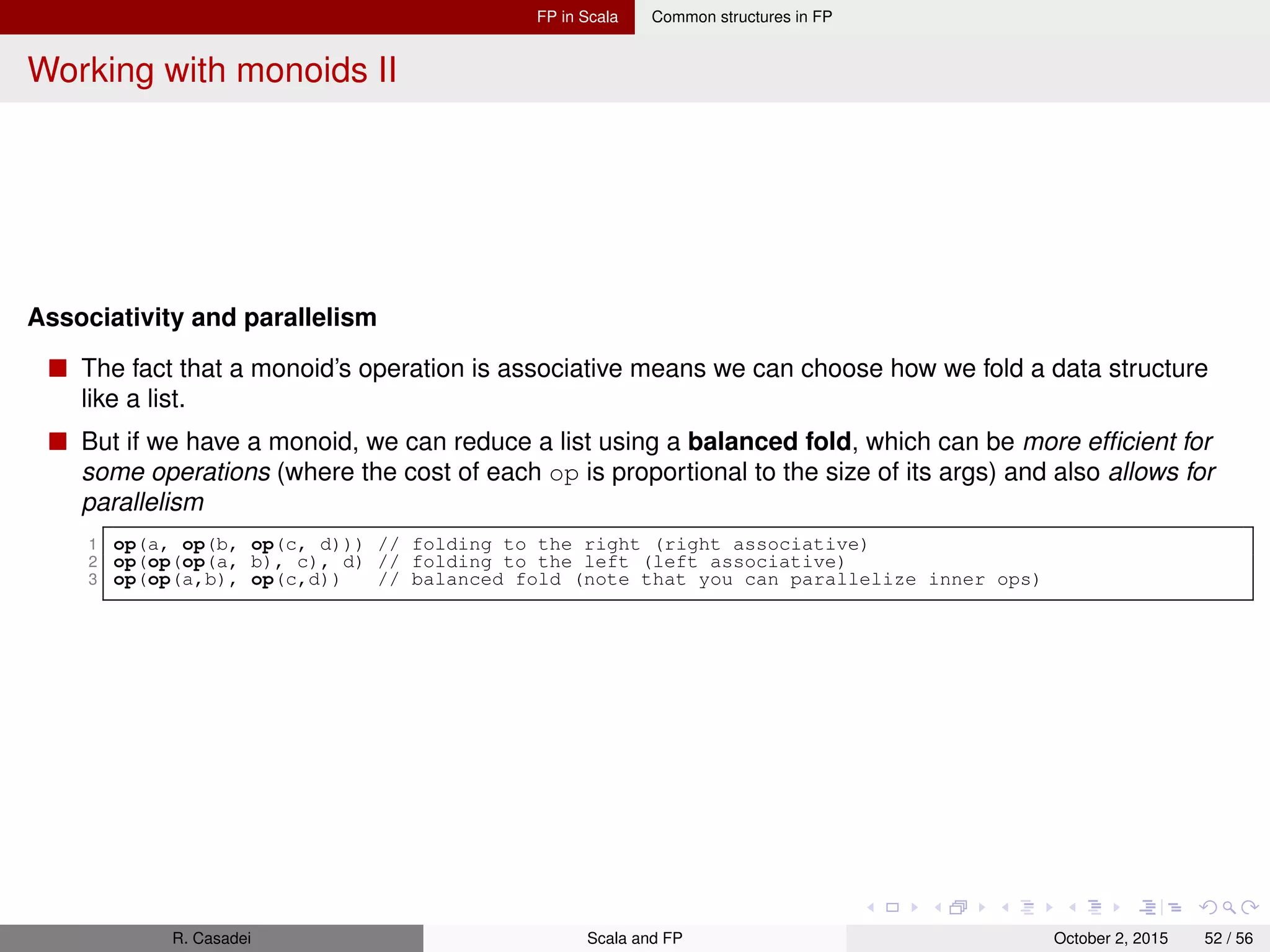
![FP in Scala Common structures in FP Foldable data structures Many data structures can be folded (lists, trees, streams, ...) When we’re writing code that needs to process data contained in one of these structures, we often don’t care about the specific shape of the structure (whether it is a list or tree, lazy or not, ...) 1 trait Foldable[F[_]] { 2 def foldRight[A,B](as: F[A])(z: B)(f: (A,B) => B): B 3 def foldLeft[A,B](as: F[A])(z: B)(f: (B,A) => B): B 4 def foldMap[A,B](as: F[A])(f: A => B)(mb: Monoid[B]): B 5 def concatenate[A](as: F[A])(m: Monoid[A]): A = foldLeft(as)(m.zero)(m.op) 6 } The syntax F[_] indicates that F is not a type but a type constructor that takes one type argument. Thus, Foldable is a higher-order type constructor (or higher-kinded type) Just like values and functions have types, types and type constructors have kinds. Scala uses kinds to track how many type arguments a type constructor takes, whether it’s co- or contravariant in those arguments, and what the kinds of those arguments are. R. Casadei Scala and FP October 2, 2015 53 / 56](https://image.slidesharecdn.com/scalafunctionalprogramming-151002171002-lva1-app6891/75/Functional-Programming-in-Scala-Notes-53-2048.jpg)
: Monoid[(A,B)] = new Monoid[(A,B)]{ 2 // ... 3 } Some data structures form interesting monoids as long as the types of the elements they contain also form monoids. For instance, there’s a monoid for merging key-value Maps, as long as the value type is a monoid. 1 def mapMergeMonoid[K,V](V: Monoid[V]): Monoid[Map[K, V]] = new Monoid[Map[K, V]] { 2 def zero = Map[K,V]() 3 def op(a: Map[K, V], b: Map[K, V]) = (a.keySet ++ b.keySet).foldLeft(zero) { (acc,k) => 4 acc.updated(k, V.op(a.getOrElse(k, V.zero),b.getOrElse(k, V.zero))) 5 } 6 } 7 8 val M: Monoid[Map[String, Map[String, Int]]] = mapMergeMonoid(mapMergeMonoid(intAddition)) 9 val m1 = Map("o1" -> Map("i1" -> 1, "i2" -> 2)); val m2 = Map("o1" -> Map("i2" -> 3)) 10 val m3 = M.op(m1, m2) // Map(o1 -> Map(i1 -> 1, i2 -> 5)) Use monoids to fuse traversals: the fact that multiple monoids can be composed into one means that we can perform multiple calculations simultaneously when folding a data structure. For example, we can take the length and sum of a list at the same time in order to calculate the mean 1 val m = productMonoid(intAddition, intAddition) 2 val p = listFoldable.foldMap(List(1,2,3,4))(a => (1, a))(m) // p: (Int, Int) = (4, 10) 3 val mean = p._1 / p._2.toDouble // mean: Double = 2.5 R. Casadei Scala and FP October 2, 2015 54 / 56](https://image.slidesharecdn.com/scalafunctionalprogramming-151002171002-lva1-app6891/75/Functional-Programming-in-Scala-Notes-54-2048.jpg)
(f: A => B): Gen[B] 2 3 def map[A,B](oa: Option[A])(f: A => B): Option[A] We can capture the idea of “a data type that implements map” as a Scala trait 1 trait Functor[F[_]] { 2 def map[A,B](fa: F[A])(f: A => B): F[B] 3 } In category theory, functors can be thought of as homomorphisms (i.e., structure-preserving maps between two algebraic structures) between categories R. Casadei Scala and FP October 2, 2015 55 / 56](https://image.slidesharecdn.com/scalafunctionalprogramming-151002171002-lva1-app6891/75/Functional-Programming-in-Scala-Notes-55-2048.jpg)
